Matador Network's Blog, page 60
March 17, 2025
The Coolest Airbnbs in Frankfurt, Germany

Frankfurt is not the first destination most travelers think to visit when they’re headed to Europe. But many will end up there regardless, if only in transit, as the city is home to one of the largest and most trafficked airports on the continent. That’s not the city’s only claim to fame — Frankfurt is also the financial capital of the European Union, housing both the headquarters for the European Central bank and one of the world’s largest stock exchanges. Whether you’re passing through en route to somewhere else or are planning a trip to Frankfurt alone, there’s plenty to do that has more to do with culture than commerce, from touring its museums and galleries, to visiting its parks, to eating your way through the city that gave the world frankfurters. These are the Frankfurt Airbnbs to book during your stay.
We hope you love these Frankfurt Airbnbs! Just so you know, Matador may collect a small commission from the links on this page if you decide to book a stay. Listed prices are accurate as of the time of publication.
Urban Studio with a Balcony Photo: Airbnb
Photo: Airbnb Photo: Airbnb
Photo: Airbnb Photo: AirbnbSee more photosThis newly renovated studio is perfect for business or solo travelers, complete with a bedroom, bathroom, kitchenette, balcony. For travelers on the go, one of the biggest perks of the apartment is that the experience is completely digital, relying on contact-free technology and a support team to ensure that every stay is seamless from check-in to check-out. Located in the heart of Frankfurt near the Frankfurt West train station, the building also comes with helpful amenities such as complimentary laundry facilities and a shared rooftop terrace for relaxation.
Photo: AirbnbSee more photosThis newly renovated studio is perfect for business or solo travelers, complete with a bedroom, bathroom, kitchenette, balcony. For travelers on the go, one of the biggest perks of the apartment is that the experience is completely digital, relying on contact-free technology and a support team to ensure that every stay is seamless from check-in to check-out. Located in the heart of Frankfurt near the Frankfurt West train station, the building also comes with helpful amenities such as complimentary laundry facilities and a shared rooftop terrace for relaxation.
One bedroom, one guest
Price per night: $92
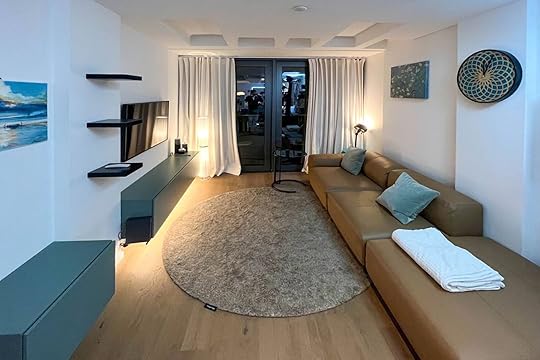 Photo: Airbnb
Photo: Airbnb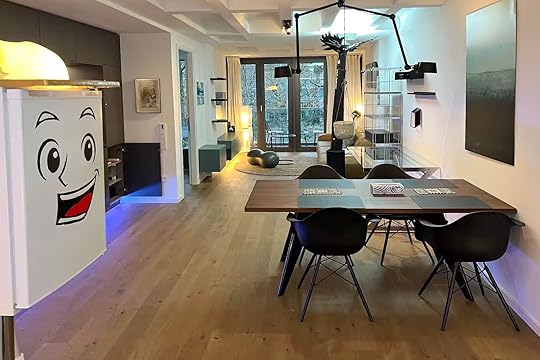 Photo: Airbnb
Photo: Airbnb Photo: Airbnb
Photo: Airbnb Photo: AirbnbSee more photosLocation is a big selling point for this one-bedroom apartment by Eschenheimer Turm, a landmark city gate on the northern side of Frankfurt and one of the tallest late gothic towers in Germany. The apartment overlooks the city’s “Central Park” in the upmarket Westend neighborhood, near the Old Opera House and other attractions. The apartment itself is a mix of classic comfort and fun decor touches, including specialty lighting in the bedroom and a modern kitchen. You’ll love the terrace outside the living room, and a parking spot is available if needed.
Photo: AirbnbSee more photosLocation is a big selling point for this one-bedroom apartment by Eschenheimer Turm, a landmark city gate on the northern side of Frankfurt and one of the tallest late gothic towers in Germany. The apartment overlooks the city’s “Central Park” in the upmarket Westend neighborhood, near the Old Opera House and other attractions. The apartment itself is a mix of classic comfort and fun decor touches, including specialty lighting in the bedroom and a modern kitchen. You’ll love the terrace outside the living room, and a parking spot is available if needed.
One bedroom, three guests
Price per night: $215
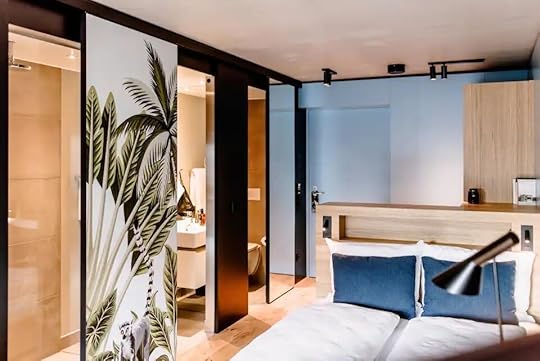 Photo: Airbnb
Photo: Airbnb Photo: Airbnb
Photo: Airbnb Photo: Airbnb
Photo: Airbnb Photo: AirbnbSee more photosThe Flag West M is a modern hotel in the heart of Frankfurt that caters to business travelers. There are 228 rooms total, all of which come with amenities like high-speed WiFi, a fridge and Nespresso machine, a jukebox, a safe, and a digital concierge that help guests get settled regardless of their length of stay, as well as communal amenities such as a rooftop terrace, gym, and coworking space. Pets are welcome for an additional fee.
Photo: AirbnbSee more photosThe Flag West M is a modern hotel in the heart of Frankfurt that caters to business travelers. There are 228 rooms total, all of which come with amenities like high-speed WiFi, a fridge and Nespresso machine, a jukebox, a safe, and a digital concierge that help guests get settled regardless of their length of stay, as well as communal amenities such as a rooftop terrace, gym, and coworking space. Pets are welcome for an additional fee.
One bedroom, two guests
Price per night: $128
 Photo: Airbnb
Photo: Airbnb Photo: Airbnb
Photo: Airbnb Photo: Airbnb
Photo: Airbnb Photo: AirbnbSee more photosLocated between two of the most popular parts of town, this one-bedroom apartment has the benefit of connecting you to all the most important parts of the city while being surrounded by green spaces and including a small balcony overlooking the garden, making Frankfurt feel a little less industrial. Techies will appreciate the devices that come with the apartment, from the Philips Hue lighting system to the Sonos speakers and Apple TV. The apartment is located a five-minute walk from the commercial area of Berger Straße where several grocery stores and supermarkets can be found, as well as many restaurants and cafes. Günthersburg Park is right across the street from the apartment for an afternoon stroll.
Photo: AirbnbSee more photosLocated between two of the most popular parts of town, this one-bedroom apartment has the benefit of connecting you to all the most important parts of the city while being surrounded by green spaces and including a small balcony overlooking the garden, making Frankfurt feel a little less industrial. Techies will appreciate the devices that come with the apartment, from the Philips Hue lighting system to the Sonos speakers and Apple TV. The apartment is located a five-minute walk from the commercial area of Berger Straße where several grocery stores and supermarkets can be found, as well as many restaurants and cafes. Günthersburg Park is right across the street from the apartment for an afternoon stroll.
One bedroom, two guests
Price per night: $126
 Photo: Airbnb
Photo: Airbnb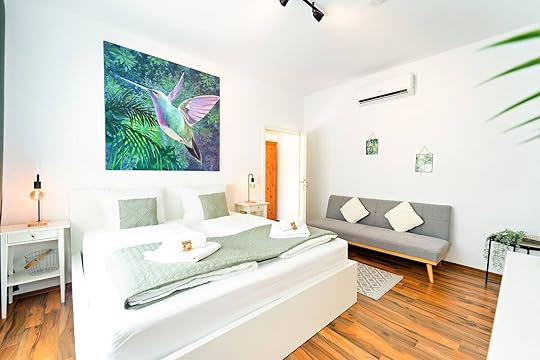 Photo: Airbnb
Photo: Airbnb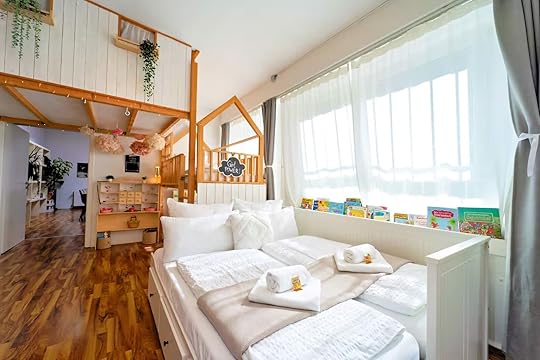 Photo: Airbnb
Photo: Airbnb Photo: Airbnb
Photo: AirbnbSee more photosThis full house and property offers guests a spacious and comfortable stay in Offenbach am Main, Hessen, Germany. This bungalow provides ample living space, a private garden, and the convenience of an on-site parking lot, making it an ideal choice for families or groups seeking a homely atmosphere. The property’s generous size and amenities ensure a relaxing and enjoyable stay.
Located in Offenbach am Main, guests are within easy reach of several notable attractions. The German Leather Museum, showcasing the history and art of leather crafting, is nearby. For nature enthusiasts, the Büsing Park offers beautiful green spaces and walking paths. Additionally, the vibrant city of Frankfurt, known for its impressive skyline and cultural landmarks, is just a short drive away, providing guests with a variety of dining, shopping, and entertainment options. This property’s prime location allows guests to explore both the local charm of Offenbach and the bustling city life of Frankfurt.
Nine guests, three bedrooms
Price: $267 per night
 Photo: Airbnb
Photo: Airbnb Photo: Airbnb
Photo: Airbnb Photo: Airbnb
Photo: Airbnb Photo: Airbnb
Photo: AirbnbSee more photosHigh rises are key to city life, and this one offers guests a convenient stay in Frankfurt am Main, Hessen, Germany. This condominium accommodates up to six guests and includes a parking spot, making it suitable for families or groups traveling by car.
The property’s strategic location provides easy access to several notable attractions. The Frankfurt Trade Fair (Messe Frankfurt), one of the world’s largest trade fairs, is within close proximity. Guests can also explore the Palmengarten, a vast botanical garden showcasing diverse plant species. For art enthusiasts, the Städel Museum, renowned for its impressive art collection, is easily accessible. Additionally, the nearby Bockenheimer Warte U-Bahn station ensures seamless connectivity to other parts of the city, allowing guests to explore Frankfurt’s rich cultural and historical landmarks with ease.
Six guests, two bedrooms
Price: $400 per night
 Photo: Airbnb
Photo: Airbnb Photo: Airbnb
Photo: Airbnb Photo: Airbnb
Photo: Airbnb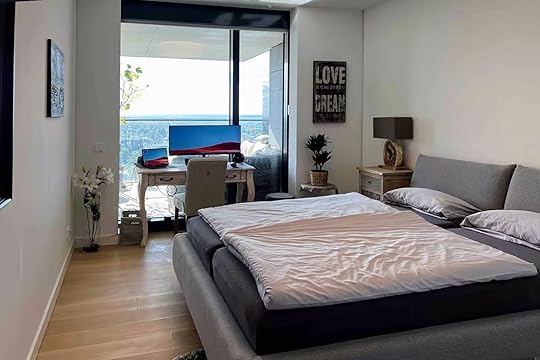 Photo: Airbnb
Photo: AirbnbSee more photosTake advantage of a contemporary stay in Frankfurt am Main, Hessen, Germany. This apartment boasts modern amenities and panoramic city views from its high-rise vantage point, providing a unique urban experience. Located in the Sachsenhausen district, guests have convenient access to several notable attractions. The Museumsufer, a cluster of museums along the Main River, is nearby, offering cultural enrichment. The Frankfurt Cathedral, known for its Gothic architecture, is also within easy reach. Additionally, the vibrant Zeil shopping street provides numerous retail and dining options, enhancing the overall stay experience.
Two guests, one bedroom
Price: $305 per night
 Photo: Airbnb
Photo: Airbnb Photo: Airbnb
Photo: Airbnb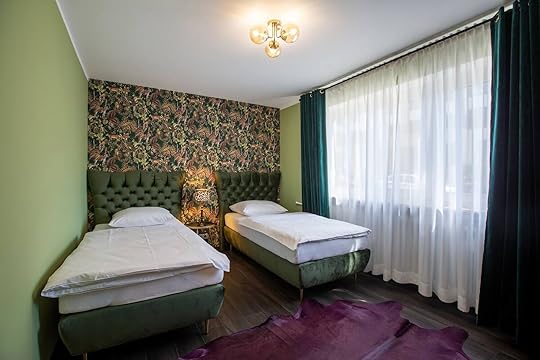 Photo: Airbnb
Photo: Airbnb Photo: Airbnb
Photo: AirbnbSee more photosFrankfurt’s prestigious Westend district is where you’re likely going to spend some time while in the city, so staying there makes everything easier. This apartment features modern amenities and spacious accommodations, making it suitable for both business travelers and tourists.
Located in the Westend, guests have convenient access to several notable attractions. The Palmengarten, a renowned botanical garden, is nearby, offering a serene environment for relaxation. The Senckenberg Natural History Museum, known for its extensive dinosaur exhibits, is also within easy reach. Additionally, the Frankfurt Messe exhibition center is accessible, making the apartment ideal for those attending events or conferences.
Four guests, two bedrooms
Price>$353 per night
 Photo: Airbnb
Photo: Airbnb Photo: Airbnb
Photo: Airbnb Photo: Airbnb
Photo: Airbnb Photo: Airbnb
Photo: AirbnbSee more photosThis brand-new flat features a large living room and a designer kitchen, providing a comfortable and stylish environment for visitors. Situated in Frankfurt am Main, guests have convenient access to several notable attractions. The Frankfurt Cathedral (Kaiserdom), known for its Gothic architecture, is within easy reach. The Römer, a historic building complex that has served as Frankfurt’s city hall for centuries, is also nearby. Additionally, the Städel Museum, renowned for its impressive art collection, is accessible, offering cultural enrichment during your stay. And, just look at those views.
Three guests, one bedroom
Price: $130 per night
 Photo: Airbnb
Photo: Airbnb Photo: Airbnb
Photo: Airbnb Photo: Airbnb
Photo: AirbnbSee more photosThis one offers guests a comfortable stay in Frankfurt’s Sachsenhausen district. This apartment features a 35-square-meter garden, providing a private outdoor space for relaxation. Amenities include access to a sauna and gym, and the property is child-friendly, offering necessary accommodations for families. Additionally, free parking is available, enhancing convenience for guests with vehicles.
Located in Sachsenhausen, guests have convenient access to several notable attractions. The Frankfurt City Forest is nearby, offering extensive trails for hiking and cycling. The Städel Museum, renowned for its impressive art collection, is also within easy reach. Additionally, the vibrant Schweizer Straße provides numerous dining and shopping options, enhancing the overall stay experience.
Five guests, three bedrooms
Price: $276 per night
 Photo: Airbnb
Photo: Airbnb Photo: Airbnb
Photo: Airbnb Photo: Airbnb
Photo: Airbnb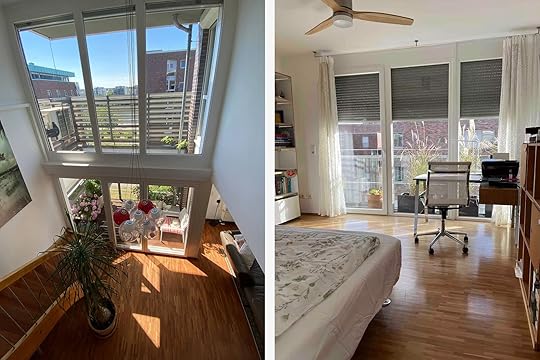 Photo: Airbnb
Photo: AirbnbSee more photosSituated along the river, guests at this apartment have convenient access to several notable attractions. The Museumsufer, a collection of museums along the Main River, is nearby, offering cultural enrichment. The Frankfurt Cathedral (Kaiserdom), known for its Gothic architecture, is also within easy reach. Additionally, the vibrant Zeil shopping street provides numerous retail and dining options, enhancing the overall stay experience.

Four guests, two bedrooms
Price: $300 per night
For Multi-Sport Days, Nothing Beats Whistler in Spring
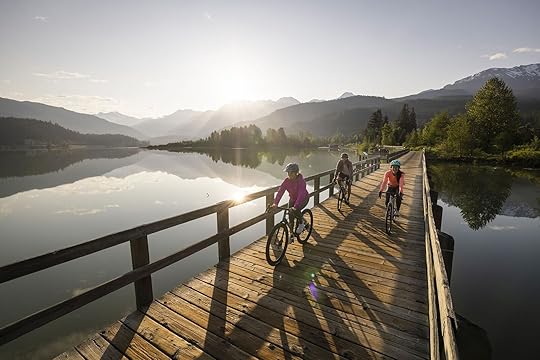
Skiers and snowboarders the world over hold Whistler Blackcomb in high regard as the largest ski area in North America. It’s a veritable winter wonderland — that much we know. But Whistler is so much more than its slopes, especially in spring. In fact, many locals and sage travelers say spring is the time to visit for an even wider range of action sports, outdoor thrills, and big wilderness — plus the bustling arts, dining, and entertainment scene that “the Village” is known for.
There are two main reasons for this: First, as the seasons transition, you can enjoy early spring savings and more availability at local accommodations, culinary deals, and better value on everything Whistler has to offer, including end-of-season skiing. (Washingtonians can save even more, thanks to an extra favorable exchange rate of $1 USD to $1.42 CAD. That’s 30 to 40 percent less right now on top of already discounted spring rates.) Second, as the days stretch out and thaw, you get even more of Whistler’s two dozen multi-sport activities in a single day.
To help you plan, save, and make the most of a trip to wonderful Whistler this spring, here are five things nature lovers, energetic travelers, and active couples and families should consider before booking their next stay.
More daylight, more sports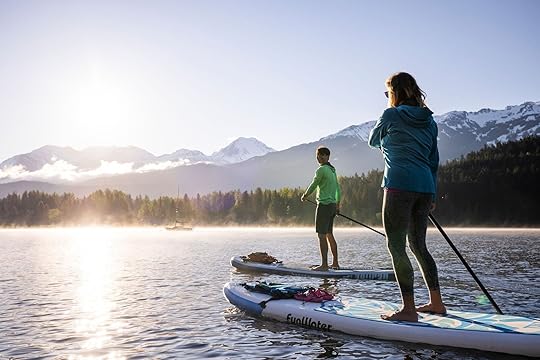
Photo: Tourism Whistler/Justa Jeskova
It goes without saying just how fast time flies. The good news is that the days get longer (and warmer) in Whistler with the arrival of spring. That means more time for biking, hiking, zip-lining, and other outdoor recreation (plus the start of golf season). Of course, ski season doesn’t end with the arrival of spring, either. So you still get Whistler and Blackcomb’s world-class slopes on top of all the added activities and daylight that shines on the Fitzsimmons Range in the Coast Mountains beginning in March. (Fun fact: March is the snowiest month.)
Maybe you’ll dedicate one spring day to water sports: Wake up to waterfront yoga, rent a SUP at Lakeside Park, take it for a spin on Alta Lake, and then up the exhilaration with some whitewater rafting on the Green River. You could start another day with righteous groomers off Blackcomb’s 7th Heaven lift, then swap the snow for a beautifully forested cross-country bike trail near Lost Lake to experience one of the area’s most peaceful pockets. (To pair downhill with downhill, Whistler Mountain Bike Park generally opens in May, too.)
Want a slower pace with a hint of a thrill? You could book a morning tee time at one of Whistler’s four golf courses — Big Sky, Nicklaus North, Fairmont Chateau Whistler, or Whistler Golf Club — then venture off-road on a two-hour Easy Rider ATV Tour through the woods. Or perhaps you’d prefer to tackle a sizable section of the Whistler Valley Trail on foot. The car-free trail network that connects Whistler’s neighborhoods and open spaces should be (mostly) snow-free by early spring, so it’s yours to meander.
You get the idea. Whistler in spring is all about two-for-one outdoor fun.
It takes a village
Photo: Tourism Whistler/Justa Jeskova
Is après-winter a thing? It should be. Because the arts, entertainment, dining, shopping, and cultural energy don’t stop in Whistler at winter’s close. In fact, the pedestrian-friendly Whistler Village is just as vibrant and more temperature-friendly in spring — and there are patios aplenty to lean into the vibe. Earn your Whistler cred at the rollicking The Longhorn Saloon or keep it breezy (literally) at HandleBar.
Late spring kicks off the Whistler Farmers’ Market. Starting in May, producers from across the region congregate at the Upper Village Stroll to share their grown-with-love crops, responsibly raised meats, pre-prepared specialties, and more. May also sees the return of the Whistler Children’s Festival, which has been entertaining families with tunes, scavenger hunts, magic shows, and roving performers for more than 40 years — longer than any other festival in Whistler. In other words, the community heats up in more ways than one with the arrival of spring.
Delicious dining for less
Photo: Tourism Whistler/Justa Jeskova
Few settings are as stunning as Whistler. But beyond the views, Whistler also “tastes” fantastic as an established culinary hotspot that successfully merges the great outdoors with fine dining. In spring, visitors can sample fresh and inspired new menus at the many restaurants, pubs, and eateries that fill the area.
Coastal-inspired, local-focused Wild Blue is one to have on your radar if you’re feeling celebratory — specifically, the seafood towers (that’s right, plural). Elsewhere, the tapas at Bar Oso and many plates of pasta at Il Caminetto are standouts for continental fare, while Sushi Village brings a whole different culinary tradition to Whistler. For something quicker (and more portable if a picnic in the park or trailside lunch is calling), Portobello is an all-day go-to for breakfast bowls and burritos, signature sammies, and baked goods (try the donuts).
Better yet, many participating restaurants offer dining deals and special rates on multi-course meals in spring. New offers on upscale Pacific Northwest cuisine, sustainable seafood, charcuterie boards, farmers market fare, noodle bowls, and loaded waffles begin mid-March — just in time to complement the overall value of spring.
Stay longer, save more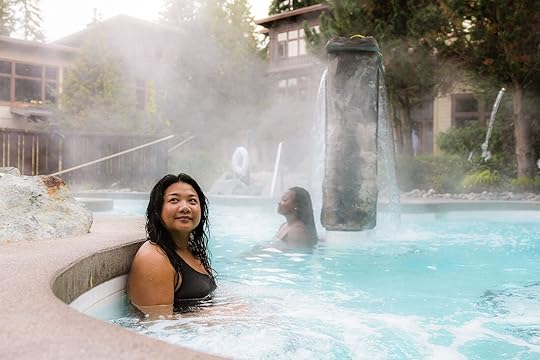
Photo: Tourism Whistler/Mirae Campbell/Scandinave Spa
Truth be told, there’s never a bad time to visit Whistler. But during spring, when virtually every activity is available, it just makes sense. This is especially true for travelers seeking extra discounts to prolong and maximize their vacation dollars. With so many ways to save in spring, you’ll want to stay longer to take it all in.
For guests coming from Washington, additional discounts and spring savings are offered to those who extend their stay to more than just a weekend. For example, a midweek stay of three nights or more at select properties in April or May starts at $95 per night. On top of that, Washington residents can sign up for free rewards and exclusive access to special offers on accommodations, activities, and events. Talk about taking advantage of all the activities that spring affords without breaking the bank.
Stay longer and do more for less (a lot less with an enticing exchange rate for those heading north). It’s a no-brainer. 
March 16, 2025
Traveling With Kids Made Easier: Packing Tips From Real Parents Who’ve Done It All
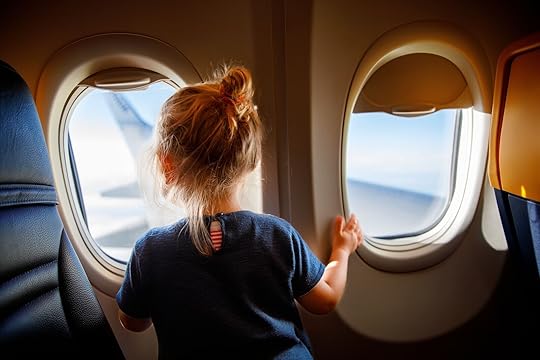
Getting anywhere with a child can test even the most seasoned traveler. Still, the effort is always worth it — yes, even if they won’t remember the trip when they’re older (but that’s a story for another time). When my daughter turned two, she had been on more than 20 flights, visited six countries, even more states, and had taken a few week-long road trips.
My wife and I got into a routine of quickly gathering what we’d need before a trip: food, snacks, water or milk, plus guesstimates for the right number of diapers, toys, and clothes. Add to that any emergency needs, wipes, travel documents and extras of, well, pretty much everything.
I’ve found a few tips that have made travel easier: mapping out road trip routes that include stops at kid-friendly outdoor spaces, saving new toys until the flight, and wrapping toys like a present to extend their entertainment value. There are even a few “travel hacks” that I’ve tested and found aren’t completely designed for viral attention.
All of the advice in the world does no good, however, if you don’t have the right kid-friendly travel bag to fit everything in an organized way. After all, the spare blowout outfit is useless if you have to dig through everything to find it while trying to minimize the mess. Following all of the international travel, road trips, and weekend getaways with my first-born, my wife and I got a good idea of what doesn’t work. Then we got our hands on the the Getaway Bag from No Reception Club.
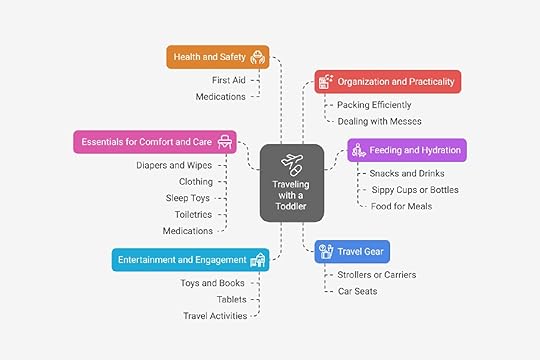
Infographic: Matador Network
More like thisLooking for a full packing list? Check out Matador’s Family Travel Packing ChecklistNo Reception Club was founded by Gemma and Daniel Ng — two frequent travelers who are also parents of young children — in 2020. After their first baby, they realized there wasn’t a bag that offered the functionality they needed while avoiding that typical “diaper bag” look. After 14 months of development, input from more than 100 parents, five bag iterations, and design help from an industry expert with experience at big-name brands like North Face, they launched the Getaway Bag backpack and Sidekick hippack, followed by the The Hideaway Carry-on Duffel and Dopp Kit. The name evokes an era when it was easier to completely unplug, before great phone service and standard free Wi-Fi just about everywhere you would want to take a child.
Real parent needs are at the heart of each design choice — and not just the needs that the Ng family saw. They gathered input from more than 100 parents in the design process, and today the brand also has The Clubhouse Community: a group of more than 10,000 parents who share knowledge on the best way to travel with young kids of all ages covering everything from strollers to packing hacks and other product recommendations.
And as a member organization of 1% for the Planet, No Reception Club donates at least 1 percent of annual sales to the non-profit Baby2Baby, which provides diapers, clothing, and necessities to children living in poverty. (To put that 1 percent into perspective: each Getaway Bag sale helps Baby2Baby distribute 20 diapers, and each Hideaway Duffel, 25 diapers.)
Needless to say, the Ngs have put more thought into optimizing travel with a little one than most. And with my second kid on the way, I tapped the founder couple to see how to make future travels even smoother with two kids in tow.
This interview has been edited for length and clarity.
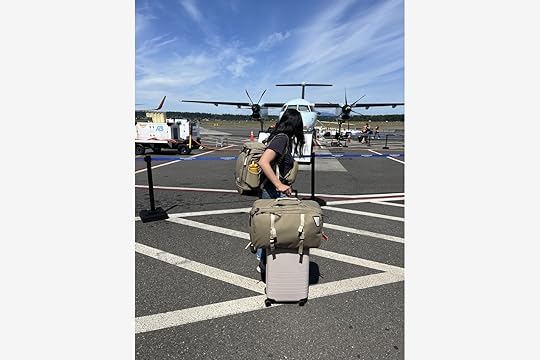
Photo: No Reception Club
Matador Network: What’s the most space-efficient method: folding or rolling clothes?Gemma and Daniel Ng: This feels like the million-dollar question when it comes to packing clothes! When we need to pack a lot of clothes for our kids, say for a trip that is a week or longer, our preference is to fold everything into stacks, which then fit neatly into the divided sections of our Hideaway Carry-On Duffel. That way, we’re able to see every item in the stack of clothing easily and remove items as needed throughout the trip.
We’ve learned that with folding, we’re able to fit a ton of children’s clothing into a small space and still visually know exactly what kind of item has been packed — for example, a sweatshirt vs. pants and so on. Additionally, because folding makes it easy to visually spot items, we’ve found this method also makes it possible for our kids to be able to access their clothes on their own, which makes it fun and interactive for them to get dressed each morning, beginning at roughly age 2.5 onward.
Whenever we pack a smaller amount of clothing, say, just for immediate needs during a flight, we prefer rolling outfits together so you can easily grab and access everything we might need in one swoop from our Getaway travel diaper bag. We always pack clothes for both of our kids to bring on board, so having them rolled together but separate from one another helps to simplify grabbing the right kid’s clothes in a hurry.
What packing techniques help reduce the overall volume of children’s clothing?Everything we pack for our kids generally has to mix and match easily to make more combinations with less clothing. Unless we are going to attend a special occasion, like a wedding, we don’t typically pack any clothing that feels too “special,” as it may take up extra space and not get used as often on a trip.
Another thing that’s easy to overdo is packing too many heavy layers. We try to avoid packing multiple bulky layers such as fleece and thick sweatpants as they can take up huge amounts of space. When the weather requires it, we will bring a couple of warmer options per kid, but generally try to focus on layering pieces that can be worn underneath for more versatility.
While it’s not a packing technique, considering places where you can do laundry while on the road is a great way to minimize overpacking. We often prioritize accommodations that have a laundry machine accessible, and when this isn’t possible, we handwash and hang dry clothes as early into the trip as we can so we can re-wear the same clothing later in the trip.

Photo: No Reception Club
What’s the ideal way to layer items in a suitcase or backpack for a long trip? Outfits by day, or organizing by type of clothing?We definitely prefer to organize our children’s clothing by category to provide better flexibility when it comes time to get dressed for the day. It can be hard to plan for the weather each day when you’re packing in advance, so having your kids’ clothing laid out in a similar organization as they are at home makes it easier to pick and choose an outfit each day.
The way our Hideaway Carry-On Duffel is laid out makes it really easy to visually spot each type of clothing at a quick glance — we personally designate each section in the packing Cubby for a different type of clothing. Additionally, when you pack items by category, they fit more snugly into each section, almost like a puzzle, so you’re able to optimize the space. And finally, our kids are old enough to want to choose their outfits on their own, and every parent knows, there’s no predicting what your kid will want to wear until the morning of!
When we’re packing just enough clothing for a day adventure in a new place, or for a quick trip, we simply roll up a couple of outfits and pack them in our Getaway travel backpack. With a backpack, this method makes it much more accessible and easy to stay organized. For a quick trip, we are bringing such a limited amount of clothing (two outfits per kid = four outfits total) compared to what we’d bring in a larger piece of luggage, that we don’t benefit from organizing things by category.
Laundry for the little ones during travel — should people consider it?We completely believe that doing laundry during travel is a great idea. When we’re booking our accommodations, we try to ensure that there is a way to do laundry while we’re there. This alleviates such a burden while traveling with your kids and ensures you aren’t over-packing.
Also, there is a pretty high likelihood that you will need to do laundry for various mishaps that happen with little ones throughout the journey, and you’ll never regret having it. For us, when we are on any trip longer than 4 days, we plan to do laundry. If the trip is more like a long weekend (2-4 days), we generally don’t bother.
Are there specific fabrics or clothing items that are easier to wash and dry quickly while traveling?Fabrics are a very personal choice whether it’s for your kids or yourself, but generally speaking, we only pack clothes that are easy to throw in the washer and dryer to make laundry an easy task. For the most part, we stick to cotton or other natural fibers for our kids because they’re versatile and easy to wear, and drying quickly isn’t a top priority as we always have some backup clothing readily available.
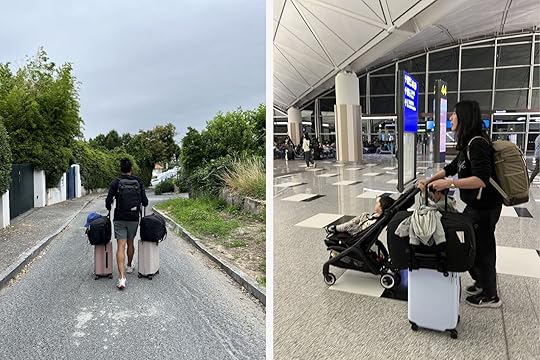
Photo: No Reception Club
How can I distinguish between necessary items and potential “nice to have” extras? Any things that are better purchased at the destination to save packing space?I think the distinction between essentials vs. “nice to haves” comes down to what items you can easily buy when you arrive at a reasonable price. When packing ahead of any trip, we consider clothing and other comforts of home as necessary items, whereas items that we’d call “supplies” — like diapers, wipes, food, and certain toiletries — we tend to buy at our destinations. We’ll usually only bring enough consumables to last us through the entire travel day, plus half a day extra as you can’t always plan for travel delays.
What are the best strategies for organizing and accessing items during travel?When you’re packing for a travel day, we recommend organizing your travel diaper bag according to the activities you will most likely engage in with your little one while in transit. We consider the main activities to be: (1) feeding them; (2) playing with and entertaining them; (3) changing their clothes if needed; (4) changing their diaper; and finally, (5) helping them fall asleep.
If you divide your backpack up according to these activities, you’ll find it very easy to quickly know where to go in your bag to grab what you need. The last thing you want during those sometimes chaotic travel moments is to feel like you are digging through a bottomless pit, unsure of where an extra pair of pants or the portable sound machine is located!
One other thought we’d be remiss to mention is easy access to your own personal items such as your phone, keys, wallet, passport, headphones, or laptop. Consolidating the items that you personally need into a couple of sections of your bag is also the optimal way to ensure your essentials are always at your fingertips.
Do you have any tips on balancing weight in a bag for a family trip?The items that we find that tend to weigh down a bag are usually non-clothing items like laptops, adult shoes, breast pumps, and so on. We do our best to spread these out as much as possible between all of the backpacks and carry-on bags we travel with to distribute the weight for easier carrying.
How should I organize items differently for carry-on versus checked luggage?While we are solidly a #teamcarryon family, we of course do also have trips that involve checked luggage too! If we are bringing carry-on instead of checked luggage, or if we are bringing checked luggage instead of carry-on, the way we organize the items inside really doesn’t differ. In both cases, we are organizing items by category within our luggage.
However, if we are bringing both carry-on and checked luggage, the way we split items is by putting children’s items into our carry-on, and adult items into checked luggage. At the end of the day, we feel that as parents we can adapt more easily if the entire checked luggage goes missing. It’s much easier for us — though not ideal — to buy some clothing at a local store and still get through a trip pretty easily if our entire trip wardrobe is lost on the way. If our little ones’ things are lost, it is certainly not as straightforward to reproduce their favorite stuffed toy that gets them to sleep every night or other sentimental items that make any destination feel more like home. 
March 14, 2025
5 Destinations for the Best Cenote, Cavern, and Cave Diving in the World
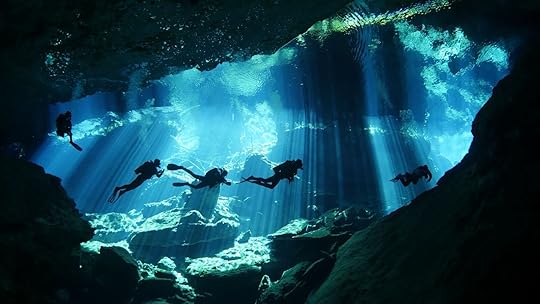
See the full list of the world’s best places to dive
Cave and cenote diving offer some of the most surreal and technically challenging experiences in the underwater world. Unlike open-water diving, where sunlight and currents dictate the environment, these dives take place in flooded caverns and subterranean tunnels, where visibility can be crystal clear but overhead environments demand precision and control. For divers with the necessary training, the rewards are unparalleled—otherworldly rock formations, shimmering light beams piercing through narrow entrances, and a silence unlike anything found in the open ocean.
While recreational cavern diving allows divers to remain in naturally lit zones with an easy exit, full cave diving requires specialized training, redundant air supply, and careful dive planning. The risks are higher, but for those prepared, cave diving provides access to some of the last truly unexplored frontiers on the planet, and places where only a tiny fraction of a percent of people have gone.
There are some key differences between cavern and cave diving, and if you don’t know what they are, then you’ve likely only done cavern diving. If you can see the sunlight and have a direct exit to the surface, it’s cavern diving. If you go beyond the light zone and need to navigate your way out, it’s cave diving. Cave divers have no natural light, need to follow a sometimes very narrow exit path to reach the surface again, and use specialized gear like sidemount setups and, often, rebreathers.
Cavern diving is generally more accessible and can be done on single tanks. Cavern divers are limited to “light zones” (always within sight of natural daylight) and can’t travel more than 200 feet from the entrance, whether that’s in depth or distance.
We’ve recommended below some of the most popular and most convenient places to stay (mostly dive resorts) in each destination. Just so you know, Matador may collect a small commission from the links on this page if you decide to book a stay.
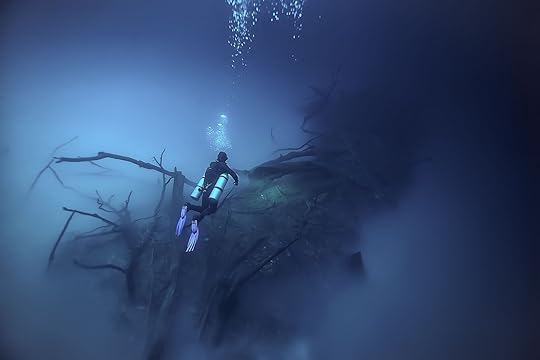
Photo: Kichigin/Shutterstock
Tulum, MexicoCan’t-miss sites: Angelita cenote, Carwash cenoteWhere to stay: Stay in town at a place like Kimpton Resort Tulum to avoid the year-round traffic delays around Tulum BeachRecommended operators: The Cenote Guy or Koox DivingBest season: November to AprilMexico’s Yucatán Peninsula is home to the world’s most extensive underwater cave systems. Cenotes, or natural sinkholes formed by limestone collapses, provide divers with an entrance into a labyrinth of submerged passageways, some stretching for miles beneath the jungle. Tulum is home to the Sac Actun System, the longest underwater cave system on the planet at more than 230 miles long. It’s a labyrinth of flooded tunnels adorned with stalactites and stalagmites formed over millennia. At cenotes like Dos Ojos and Carwash, divers can navigate between light-filled chambers and dark, cavernous passages.
Tulum requires buoyancy precision to avoid stirring the fine silt that can reduce visibility to zero. Some cenotes, like The Pit and Angelita, have surreal hydrogen sulfide layers at roughly 100 feet deep, mimicking an eerie underwater river. It’s pitch-black beneath the layer, and lightweight items like leaves will sometimes float on top of it. It’s wildly unique and otherworldly to see, but you’ll need to be an advanced open water diver, and Nitrox is highly recommended.
Advanced certifications are always recommended for divers exploring cave systems, but the lack of currents (or wildlife) in Tulum means many sites are open to beginner divers, though they’ll need to stay in naturally lit areas fairly close to the entrances.
Northern FloridaCan’t-miss sites: Ginnie Springs is probably the most popular, as well as one of the prettiestWhere to stay: Blue Grotto Dive Resort is basic, affordable, and steps from the Blue Grotto dive sitesRecommended operators: Rent gear from Ginnie Springs Outdoors, or book guided cave dives with North Florida Cave TrainingBest season: Fall and winterNorthern Florida has the best cave diving in the US, with caves formed as the result of millions of years of geological transformation. Much of northern Florida is limestone, and over time, a vast underground aquifer (the Floridan Aquifer) dissolved the porous rock, creating an extensive network of tunnels, sinkholes, and submerged chambers. As the underground channels expanded, some collapsed to form sinkholes and springs, while others evolved into giant underwater chambers that divers can explore today. The whole area is collectively referred to as Florida’s “Cave Country.”
Ginnie Springs, just outside High Springs, is a well-known training site, known for its high-visibility water and the Devil’s Spring System, including Devil’s Eye, Devil’s Ear, and Little Devil. Beginners can find more approachable cavern systems around Morrison and Vortex Springs, near the town of Ponce de Leon.
Corfu, GreeceCan’t-miss sites: Colovri Cave for advanced divers, The Hole of HaWhere to stay: Ikos Dassia has high-end, brand-new rooms, plus a robust on-site dive centerRecommended operators: Achilleon Diving CenterBest season: May to OctoberCorfu is beautiful above the surface, but its underwater landscape is equally beautiful when it comes to diving. The island’s coastline is dotted with numerous caves and caverns, making it the best place to cave dive in Europe.
Visibility in Corfu’s waters is typically excellent, often reaching up to 90 feet. However, water temperatures can change quite a bit, ranging from 75 to 85 degrees Fahrenheit in the summer to the high 50s in winter. It’s a great place to dive if you want to do some cavern and cave diving, but don’t want that to be the whole focus of the trip. Many sites offer a mix of open water and cavern diving, with some caves accessible to less experienced divers and others requiring advanced certifications. One of the coolest sites is the Monastery, with an impressive underwater arch about 50 feet deep, and a 30-foot-long underwater tunnel filled with colorful fish. It’s suitable for all open water divers.
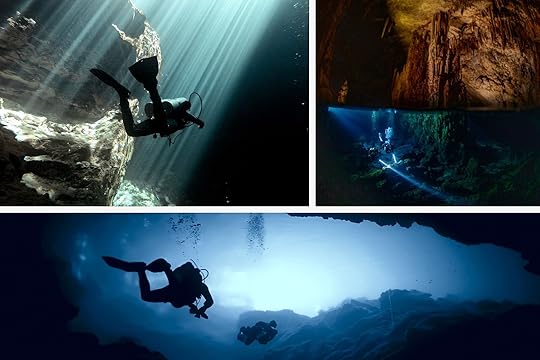
Photos: Suzie Dundas, PADI, and Kichigin/Shutterstock
Playa del Carmen, MexicoCan’t-miss sites: Garden of Eden and Chikin Ha cenotesWhere to stay: Royal Hideaway Playacar is an adults-only all-inclusive with an on-site dive centerRecommended operators: Deep Dark Diving, or Dive Paradise if you’re staying in CozumelBest season: Year-round, depending on your goalsIt’s not just Tulum that has great access to cenotes. Travelers staying around Playa del Carmen have plenty of options for cenotes that don’t require a long drive south. That makes them more accessible for quick trips, since there’s a large international airport in Cancun. Even divers in Cozumel can come to the mainland for a day, as many companies offer full-day trips from the island of Cozumel that include your ferry ride to the island and pick-up in Playa.
Chikin Ha is only about 30 minutes from downtown Playa del Carmen, and close to many dive shops. Cenote Jardín Del Eden is also pretty close, so it’s easy to dive both in one day. And about an hour north is Cenote Azul Ha, a beginner-friendly site. It’s relatively shallow, but features stunning limestone formations and crystal-clear water, making it an excellent introduction to cenote diving. Visibility is always better in the winter dry season.
Playa del Carmen may be a better pick than Tulum for visitors who want to cavern dive for a day or two, but don’t want it to be the entire focus of their trip. Certified divers can also get in the water with relatively docile bull sharks just off the shores of Playa del Carmen.
The Abaco Islands, BahamasCan’t-miss sites: Anywhere in Dan’s Cave or Ralph’s CaveWhere to stay: Abaco Beach Resort is near dive shops and popular Mermaid Reef BeachRecommended operators: Bahamas Underground Best season: November to MayDiving in the Bahamas is usually associated with the same reefs, gentle currents, and colorful fish that define dive sites throughout most of the Caribbean. But Great Abaco and the other Abaco islands in the Bahamas is distinct for its intricate cave systems under the pretty island. Divers can go under the surface from the coast or from inland cave systems, like Dan’s Cave located in one of the island’s pine forests. It has more than 17,000 feet of mapped passages, exceptional visibility, and expansive rooms with crystal stalactites and stalagmites. In Dan’s Cave, rebreather and mixed-gas divers can explore a room called “Fangorn Forest,” named after an ancient forest in the Lord of the Rings books.
Great Abaco also has plenty of great coastal diving, including sites with swim-through and arched reef formations. There are lots of popular sites around Pelican Cays Land and Sea Park, a 2,100-acre marine preserve established in the 1970s.
Where can you find diveable caves and cenotes?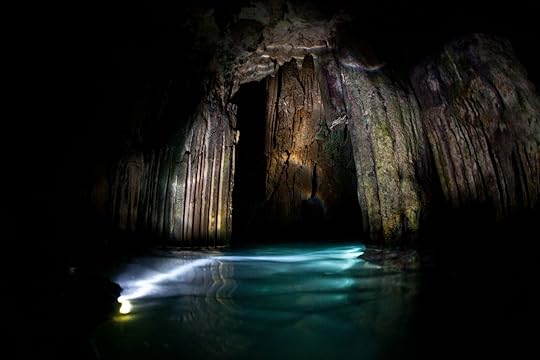
Photo: Ethan Daniels/Shutterstock
Most underwater caves are formed in karst, where soluble rock (usually limestone) is slowly dissolved by the flow of groundwater over thousands or millions of years. As the rock dissolves, it creates voids that sometimes fill with water as sea levels change. In some cases, the roofs of those voids collapse, creating sinkholes (or cenotes). The remains of cave system may also exist underwater in the form of swim-throughs in open ocean environments, while areas with high volcanic activity may have underwater caves and tubes formed by ancient lava flow.
Diving in caves and caverns is one of the most specialized and advanced types of diving available, and requires a serious education component to get certified. If that doesn’t float your boat, you can find a similar experience in some coral reefs with tower or tube formations. They’ll give you a chance to feel what it’s like to dive in a narrow, tight area for only a few seconds, rather than committing to it for a full hour-long dive. Read more about how scientists discovered the world’s longest underwater cave system, explore 18 awesome cave tours open to the public, and read about the controversy over the Tren Maya through Mexico’s cenote country. 
The 5 Best Liveaboard Diving Destinations in the World
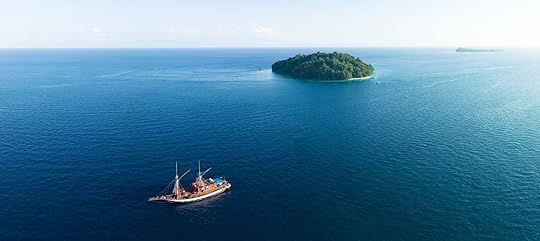
See the full list of the world’s best places to dive
Liveaboard diving is the ultimate way to experience the ocean. These immersive, expedition-style journeys take divers far beyond the reach of day boats and crowded reefs. Unlike land-based dive trips, where the best sites may be hours away, liveaboards put divers right in the center of the action, waking up each morning just minutes from world-class dive sites. From remote seamounts teeming with pelagic life to pristine coral atolls untouched by human traffic, liveaboards provide access to the most breathtaking and least-explored underwater landscapes on the planet.
Diving from a liveaboard isn’t just about the locations—it’s about the rhythm of life at sea. Days are structured around diving, with multiple dives per day, followed by onboard meals, dive briefings, and surface intervals spent lounging on deck or reviewing underwater footage. Without the constraints of shore-based logistics, dive plans can be more flexible, adjusting to tide changes, marine life activity, and weather conditions to ensure the best possible experience.
While liveaboard trips are usually fairly relaxed, it’s still an intense level of diving, with four or sometimes five dives per day. You’ll want to know your limits, and skip a dive or two if you get too tired. Especially on longer trips, it’s very common for divers to skip a dive or two. Liveaboard trips are about going farther, diving longer, and seeing the ocean in its purest, wildest form. For those who want to experience the underwater world at its most remote and untouched, a liveaboard is the only way to go.
We’ve recommended below some of the most popular and most convenient places to stay (mostly dive resorts) in each destination. Just so you know, Matador may collect a small commission from the links on this page if you decide to book a stay.
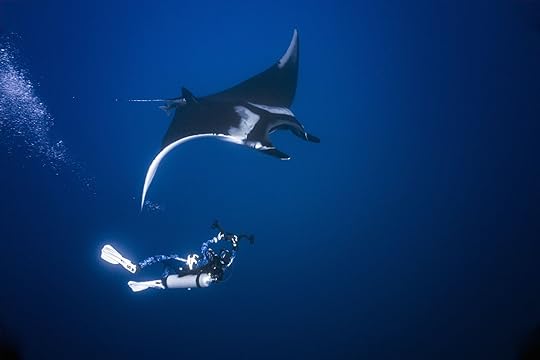
Photo: Julie Andersen/PADI
Rowley Shoals, AustraliaCan’t-miss sites: Clerke Channel for wild drift diving, Mermaid Wall for coral and crittersWhere to stay: Liveaboard onlyRecommended operators: Odyssey Expeditions is the most well-known Best season: September to NovemberLocated about 160 miles off the northern coast of Western Australia, Rowley Shoals is a group of three coral atolls rising from more than 1,000 feet below the surface. Each is surrounded by a shallow, healthy lagoon. Among dive sites that can be reached by the public, it’s one of the least-dived in the world, with some sources citing just 200 divers per year. That makes the sites nearly untouched by humans, with visibility regularly in the 130-to-150-foot range. The sites are quite varied, from leisurely reef dives around the lagoons to speedy drift dives where you’ll want to make sure you know how to use your SMB.
Southern Red SeaCan’t-miss sites: The Brothers Islands for sharks, Elphinstone Reef for drift divingWhere to stay: If you don’t do a liveaboard, the farthest south you can stay is around Marsa Alam, at places like Marsa Shagra Village. Recommended operators: Emperor has several ships focused on the southern Red SeaBest season: AutumnMany locations in the Red Sea are fantastic for diving, and much of the northern part can be explored while staying at luxury resorts near places like Sharm-el-Sheihk. But if you want to explore the southern Red Sea, you may be better off taking a liveaboard trip. The northern part is known for wrecks, but when it comes to the southern part of the Red Sea, it’s pelagics that are the big draw. That includes hammerheads, oceanic whitetips, threshers, and the occasional whale shark.
Many of the most popular dive sites, such as The Brothers and Daedalus Reef, are too far from shore for day trips. That means many fewer people dive them, so they’re both less impacted by human activity and less likely to be crowded, increasing your chances of bigger creatures lingering for a little longer. The southern Red Sea also extends into Sudan and Eritrea, where it’s harder to find safe on-land accommodations.
Diving in the southern Red Sea is possible all year long, and it’s known for being one of the most affordable liveboard locations in the world. It’s more beginner friendly than other liveaboard locations, but still slightly more challenging than the reefs and wrecks to the north. You’ll probably want the experience from about 50 logged dives, and it’d be good to have some experience in currents and drifts.
Tubbataha Reef, PhilippinesCan’t-miss sites: Washing Machine for sharks, Malayan Wreck for mantis shrimp and nudisWhere to stay: Liveaboard onlyRecommended operators: The Aggressor Fleet is quite popular, but Solitude One looks gorgeous, too Best season: March to JuneTubbataha Reef is one of the world’s most biodiverse marine environments, sitting in the Sulu Sea. It’s a UNESCO World Heritage Site and a National Marine Park in Indonesia. That protected status (plus the remote location) means the reef is known for pristine coral, healthy vertical walls, and an abundance of marine life.
Divers can expect encounters with large pelagic species, including various shark species, manta rays, and whale sharks. Visibility is often 100 feet or more, and there are plenty of dives in the 15 to 80 foot range for max depth — something rare in the world of liveaboards. While it doesn’t have quite the diversity of, say, Raja Ampat, it’s still home to more than 600 fish species and 350 types of corals. It’s only diveable for a short window in the spring, as monsoon seasons and rough sea conditions make it too challenging to dive the rest of the year.
That means you should plan your trip well in advance, as the limited season and Tubbataha’s popularity mean liveaboards fill quickly. Diving on the reef isn’t as challenging as sites like Socorro or even Galápagos — no reef hooks allowed in Tubbataha — but you should still be comfortable with drift diving.
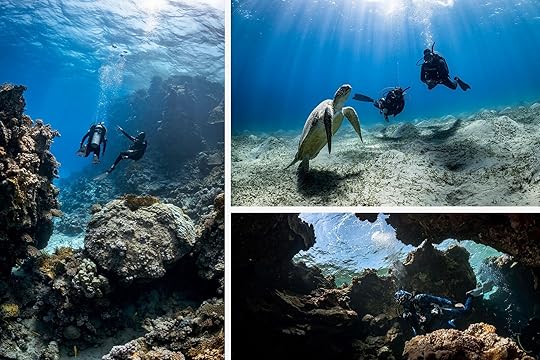
Photos: PADI
Socorro Island, MexicoCan’t-miss sites: Cabo Pearce for mantas, Roca Partida for hammerheads Where to stay: Liveaboard only Recommended operators: Nautilus Liveaboards seems to be beloved by anyone who’s done a tripBest season: December to MaySocorro is an uninhabited island about 250 miles off the coast of Baja California, in the Mexico’s Revillagigedo Archipelago. This protected biosphere reserve is teeming with pelagic life, and most known among divers for its abundance of large marine species. Divers can expect encounters with various shark species, including hammerheads, silky, and white tips, as well as humpback whales, dolphins, and the area’s famous giant manta rays.
The extreme remoteness means liveaboard diving is the only way to access Socorro, and diving conditions can be challenging, making it best reserved for experienced divers. Water temperatures range from the high 60s to low 70s Fahrenheit, and the best diving season is from November/December to May, coinciding with humpback whale breeding season and optimal manta ray sightings.
Raja Ampat, IndonesiaCan’t-miss sites: Cape Kri holds the world record for the most species sighted on a single dive Where to stay: If you don’t use a liveaboard, Papua Paradise Eco Resort partners with on-site Gangga DiversRecommended operators: The number of liveaboard options seem endless, but Gaia Love is one of the highest ratedBest season: Year-round, but summer offers the calmest conditions and best visibilityLiveaboard diving in Raja Ampat is a chance to sleep above one of the world’s most biodiverse marine environments. Raja Ampat is in the center of the Coral Triangle and has more than 1,500 islands and cays, creating a labyrinth of waterways perfect for divers. More than 75 percent of the world’s known coral species are found in Raja Ampat, and the remote location means its reefs are pristine.
Liveaboard diving is the best way to experience Raja Ampat as it allows access to remote dive sites unreachable by day boats, plus, you won’t find many hotels scattered on the remote islands. Liveaboards can also cover large distances overnight, maximizing your diving time and letting you explore the northern and southern parts of the archipelago in one trip. Raja Ampat’s dive sites are not particularly deep, but strong currents (including downcurrents) make it recommended for more advanced divers, especially as you may need to use a reef hook when currents and swells are at their peak.
How much does a liveaboard dive trip cost?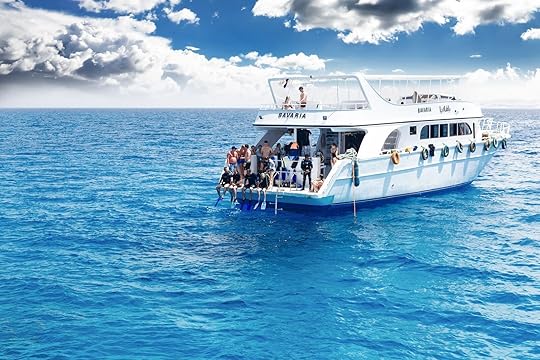
Liveaboard destinations like the Red Sea are known for their affordability. Photo: BY-_-BY/Shutterstock
The cost of a liveaboard dive trip varies widely depending on the destination, duration, type of vessel, and level of luxury. Budget-friendly liveaboards in places like Egypt’s Red Sea or Southeast Asia can start at around $100 to $200 per night per person, including meals, basic accommodations, and several dives per day. Mid-range options, which offer more comfortable cabins, better food, and added amenities like onboard Wi-Fi or entertainment, typically cost between $250 and $400 per night. High-end liveaboards in premier dive destinations such as the Galápagos, Maldives, or Raja Ampat can range from $400 to over $1,000 per night, especially if they have to cover a long distance to reach dive sites.
Luxury liveaboards usually have roomy cabins, gourmet meals, and on-board amenities like sun decks, hot tubs, massage services, and comfortable indoor lounge spaces. Budget liveaboards typically offer basic cabins with bunk beds and shared bathrooms, while luxury options provide spacious, air-conditioned en-suite cabins with premium bedding and sometimes ocean views. They may also include add-ons like nitrox, specialty dives, sodas and drinks, or Wi-Fi, while budget trips may not include them in the cost. The diving is often the same no matter how much you pay, so it comes down to what level of luxury you want onboard. 
The 5 Best Places Around the World to Dive With Whale Sharks, Mantas, and Other Pelagics

See the full list of the world’s best places to dive
Love the idea of being in the water with big marine creatures, but not too keen on sharks? Then pelagic diving may be up your alley. The chance to dive with whale sharks, mantas, and other big fish known as “pelagics” is a distinct experience from the reef dives most divers are familiar with. Pelagics are large, open-ocean species like sharks, rays, tuna, and billfish, all of which thrive in deep water away from the shelter of coastal reefs. During pelagic dives, the focus is open the open expanse and the creatures that navigate it, not colorful corals or tiny schools of fish.
Pelagic dives often take place in deeper waters, where strong currents and unpredictable conditions are common. They’re often drift dives, as large creatures frequently travel in stronger currents. The absence of reef structures means fewer visual cues, creating a sense of endlessness that heightens the thrill when a large marine creature suddenly appears — a quiet dive can quickly turn into an unforgettable encounter in a second.
Because pelagics are powerful swimmers that cover vast distances, sightings are never guaranteed. However, the sites below are places where large schools of pelagics are known to congregate, either at certain times of the year when they migrate or due to year-round populations. In some cases, you may have to travel quite far from land to reach the sites, though some are in shallow areas where pelagics congregate at certain times. Dives are often timed with specific conditions, like tidal changes, to increase the chances of encounters. Safety protocols may be more stringent, as divers need to be comfortable with open-water ascents, rapid descents in choppy conditions, and quick responses to shifting currents.
Sharks, too, are technically pelagics. But for the sake of making this guide easier to use, and because shark diving is so popular, that’s it’s own category.
We’ve recommended below some of the most popular and most convenient places to stay (mostly dive resorts) in each destination. Just so you know, Matador may collect a small commission from the links on this page if you decide to book a stay.

Photo: Divefriday/Shutterstock
Cenderawasih Bay, IndonesiaWhere to stay: It’s almost always done via liveaboard only Recommended operators: Coralia Liveaboard, Calico Jack ChartersBest season: March to MayIf diving with whale sharks is the most important goal on your dive vacation, head to Cenderawasih Bay, where there’s the rare opportunity to see whale sharks in shallow water. It’s in the remote Bird’s Head Peninsula of West Papua and has become a hotspot for whale shark interactions due to the presence of traditional bagan fishing platforms. Local fishermen use small baitfish off these platforms to attract the fish they’re trying to catch, drawing the attention of whale sharks. Unlike many other locations where whale shark encounters are brief or fleeting, the sharks here linger, creating extended and intimate interactions.
The whale sharks here are unusually comfortable around humans and fishing boats, sometimes staying for hours as they feed on the baitfish spilling from the nets. Divers often find themselves swimming alongside these gentle giants for the entirety of their dives. It’s one of the best places in the world to take photos with just a GoPro, thanks to the combination of giant fish (they can be up to 30 feet long), shallow depth, and fact that the whale sharks don’t scurry away from humans. It’s a relatively new destination for divers, with lots left under the water to explore.
Nusa Penida and Nusa Lembongan, Bali, IndonesiaCan’t-miss sites: Manta Point, the Blue Corner Where to stay: Sunset Star Huts are tropical, affordable, comfortable, and within walking distance to beaches and dive shopsRecommended operators: Two Fish Divers for multi-island dive packages, Legends Diving Lembongan is also a great pick Best season: July and AugustNusa Penida and Nusa Lembongan, off the coast of Bali, are known for some of Indonesia’s most thrilling marine encounters — particularly with manta rays and the elusive mola mola. Manta Point off Nusa Penida is a cleaning station where reef mantas, with wingspans reaching up to 15 feet, ride the currents to the relatively shallow dive site. Divers can often see multiple mantas circling in a slow, hypnotic ballet as small reef fish clean their bellies.
Equally prized is the chance to encounter mola mola, or giant ocean sunfish. Mola mola usually live in cold, deep water 650-to-2,000 feet below the surface. However, they often come into shallow cleaning stations early in the morning, before there are too many divers to scare them away. You may see them at Manta Point, as well as other well-known sites like the Blue Corner and Crystal Bay. Because of the strong currents, it’s recommended that divers have an advanced open water certification before heading to Nusa Lembongan.
TongaCan’t-miss sites: Hunga Magic and Hot Spring CavernWhere to stay: Serenity Beached Resorts is focused on humpback whale snorkeling, Matafonua Lodge is a full-service dive resortRecommended operators: Dive Tonga, if your hotel doesn’t have a shopBest season: August and SeptemberIf you’re dreaming of seeing humpback whales underwater, you’ll want to make the trip to Tonga, a country of more than 170 islands west of Australia. Each year, from July to October, thousands of humpback whales migrate from the frigid feeding grounds of Antarctica to the warm, sheltered waters of the Vavaʻu archipelago to breed and give birth. Tonga is one of the few places on earth where swimmers and snorkelers are legally allowed to enter the water with these gentle giants under regulated conditions. If you book humpback whale tours, they’ll only be for snorkeling or swimming.
However, you can dive in Tonga during humpback whale season, which means there’s a chance you may be able to see them on any given dive in the area. The chances are still somewhat slim, but much higher than they are almost anywhere else in the world. Many divers head to Tonga for a few days of diving around Vava’u, the northernmost point of the country, before dedicating a day or two to seeing humpbacks from the surface. That way, snorkeling with the whales is a back-up option if you don’t see them on dives.

Photos: Alex Rush/Shutterstock, Rich Carey/Shutterstock, and Ethan Daniels/Shutterstock
Inhambane, MozambiqueCan’t-miss sites: Manta Reef, Anchor Bay Where to stay: Liquid Dive Adventures offers dive packages and beach bungalows, but there are a solid number of options in the areaRecommended operators: Try Tofo Scuba or Peri Peri Divers Best season: June to OctoberMozambique may not be the first destination people think of when planning dive trips, but its long stretch of coastline offers some of the most rewarding pelagic encounters in the Indian Ocean. The waters off Inhambane, particularly around Tofo Beach and Barra, are known for their currents, giving divers a good chance of seeing big creatures no matter the time of year. You may be able to dive with whale sharks on any given month as they come and go, but the region is known for sand tiger sharks in December and January, large tuna in March and April, and humpback whales from June to September.
Tofo is considered one of the best places in the world to swim with whale sharks, and mantas are common at sites like Manta Reef. It’s the strong currents in the region that bring larger species in, so be prepared for mostly drift dives, where you may cruise past larger schools of fish like barracuda, tuna, and marlin. This page has a great chart of what species you may see when.
Sipadan, MalaysiaCan’t-miss sites: The Drop Off, Barracuda PointWhere to stay: Borneo Divers Mabul Resort for budget-friendly luxury, or Seaventures Dive RigRecommended operators: Scuba Junkie Sipidan knows how to find the good stuffBest season: April to JuneSipidan is an island that rises 2,000 feet from the ocean floor. It was formed by a volcanic cone, creating an associated volcanic topography under the surface. It has steep walls and drop offs, making it easy for bigger creatures to come up from the depths and cruise through the nutrient-rich water. Because of this, it’s a hot spot in Malaysia for big marine life encounters.
Schooling barracuda and jackfish are a signature sight at Sipadan, often so tight they resemble fish tornados in the deep blue. Sharks like grey reef and whitetips are common, though hammerheads may occasionally make an appearance. Green and hawksbill turtles are a common sight, too.
One of the most well-known dive sites in Sipadan for pelagic diving is the Drop Off, a vertical wall known for tuna, giant trevally, and the elusive thresher shark. As with most sites in Sipidan, strong currents are common, and most dive operators will require or strongly suggest divers have an advanced open water certification.
Where else can you dive with whale sharks (and other big stuff)?
Photo: wildestanimal/Shutterstock
Diving with large pelagic species is usually going to mean venturing into deeper water, no matter where in the world you are. They’re often at sites with strong currents and updrafts that bring plankton higher up, which bring fish higher up, which bring pelagics higher up. Deep drop-offs and oceanic pinnacles are also common features of pelagic hotspots, often acting as cleaning stations for mantas and other large species.
Many pelagic species follow predictable migration routes linked to seasonality, water temperature, and food availability. Whale sharks, for example, often appear during coral spawning events or plankton blooms, while humpback whales migrate to warmer waters to give birth. As a general rule, the larger an animal is, the fewer of them there are, so you’ll always want to plan multiple dives at a specific site if seeing pelagics is your goal.
A good place to start is by looking at the Professional Association of Diving Instructors (PADI) listing for the place you’re thinking about diving — many have tables showing what species are present in which months. These tables can help guide when and where you should go; for example, you should head to Komodo in the summer to see black-tip reef sharks. If you’re headed to La Paz, go in October to possibly see hammerheads, and December through March to see grey whales.
Other places known for the ability to dive with whale sharks and other big species include the Galápagos Islands between June and November, Richelieu Rock in Thailand between November and May, and Australia’s Ningaloo Reef between March and July. Read more about places you can swim (not dive) with whale sharks in Mexico, the story of a whale watching guide in Tonga who lived alone on an island for more than a year, or places around Queensland, Australia, where you can see fantastic marine life no matter what time of year. 
The 5 Best Scuba Destinations in the World for Drift Diving
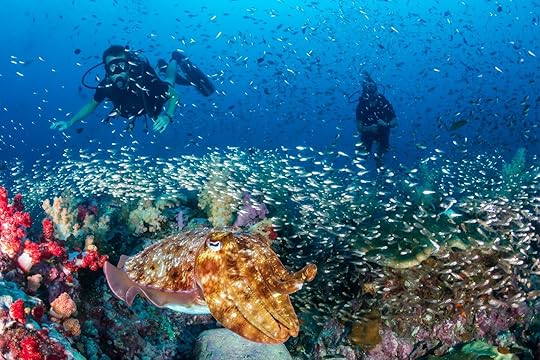
See the full list of the world’s best places to dive
Drift diving is one of the most exhilarating experiences in the underwater world. Unlike standard reef dives, where divers move at their own pace, drift diving transforms the ocean into a natural conveyor belt, carrying divers along powerful currents as if they’re flying weightlessly through an ever-changing landscape. It’s an amazing sensation, gliding past towering coral walls, weaving through schools of fish, and watching as sharks, manta rays, and pelagic species appear effortlessly in the blue, riding the same currents that propel you forward.
While some drift dives are gentle and slow-moving, others demand careful planning, precision, and control. Fast-moving channels, open-ocean currents, and unpredictable conditions mean drift diving requires strong buoyancy skills, situational awareness, and the ability to deploy a surface marker buoy (SMB) for safe ascents. The unpredictability is part of the thrill — one moment, you’re hovering over a vibrant coral garden, and the next, you’re being swept along a deep ocean ridge, surrounded by pelagic hunters.
There are significant differences between basic drift diving and advanced current diving. If you’ve casually floated along a reef with mild movement, you’ve done a drift dive. But if you’ve had to hook into a reef, navigate high-speed currents, or execute mid-water ascents because surfacing at the wrong spot could take you miles from the dive boat, you’ve likely experienced advanced current diving. If you’re worried about currents, a good thing to remember is that currents carry everyone at the same speed, so you’ll still be with your group the whole time. In mild to moderate currents, simply putting a finger down on a rock (not live coral) is enough to hold you steady.
Drift diving can be as relaxing or as intense as conditions allow, but it’s always dynamic and full of surprises. For those seeking high-adrenaline experiences, few things compare to the rush of flying weightlessly through the ocean.
We’ve recommended below some of the most popular and most convenient places to stay (mostly dive resorts) in each destination. Just so you know, Matador may collect a small commission from the links on this page if you decide to book a stay.
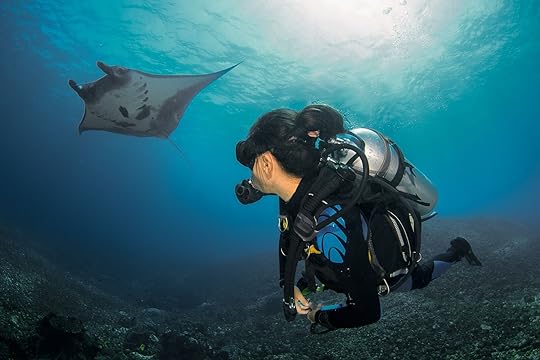
Photo: SergeUWPhoto/Shutterstock
Cozumel, MexicoCan’t-miss sites: Palancar Reef, Santa Rosa WallWhere to stay: Presidente InterContinental Cozumel Resort & Spa has an on-site dive shop and a swimmable private beachRecommended operators: If your hotel doesn’t have one, Barefoot Dive Center or Scuba TonyBest season: Year-roundCozumel offers some of the easiest and most beginner-friendly drift diving in the world. The island sits on the Mesoamerican Barrier Reef — the second-largest reef system in the world that includes Belize’s famous Great Blue Hole — creating consistent, predictable currents that flow northward along the island’s western coast. These currents allow divers to drift effortlessly along the reef, using little energy while covering long distances.
Reefs around Cozumel range from steep walls to coral pinnacles, with plenty of sandy channels for spotting smaller creatures. Sea turtles are common, and water is reliably warm enough for a 3mm shorty year-round. Visibility is usually at least 50 feet but can be well above 100, and boat rides are often no more than 10 or 15 minutes if you stay toward the southern part of the island. Cozumel has an airport but is also reachably by a ferry from Playa del Carmen, which you can use for day trips to dive in cenotes on the mainland.
Komodo, IndonesiaCan’t-miss sites: Batu Bolong, Golden PassageWhere to stay: You’ll find dive packages at both Komodo Dive Resort and Dragon Dive Komodo Recommended operators: If not doing a liveaboard, try Komodo Dive Center or Manta Rhei Dive Center, both in Labuan BajoBest season: April to OctoberKomodo is known for its powerful currents, as it sits within the Indonesian Throughflow, where the Pacific Ocean meets the Indian Ocean. The result is strong tidal exchanges (strong currents flowing in or out), which are full of nutrients from either ocean. That draws in larger pelagics. Schools of fusiliers, trevally, and barracuda are common, as are mantas and reef sharks (including whitetips and blacktips). In deeper, cooler waters, you might even encounter rare species like the elusive mola mola.
Water temperatures can vary significantly depending on the site and season, ranging from the high 60s to low 80s Fahrenheit. In general, cooler water brings better visibility, and tends to attract more big creatures, especially around the southern part of Komodo National Park. Currents can be intense and unpredictable, often requiring quick descents and advanced buoyancy control on downcurrents. When it’s very strong, it’ll feel like a conveyer belt taking you past sloping reefs and coral-covered pinnacles. Before going to Komodo, you should have experience with and comfort in strong currents — your reward will be access to one of the most biologically rich marine environments in the world.
Okinawa, JapanCan’t-miss sites: Toilet Bowl, any sites around Zamami IslandWhere to stay: Both Hotel Strata Naha and JR Kyushu Hotel Blossom Naha have big pools and are close to the beachRecommended operators: SeaSir does pickups at hotels in town, while Craft Dive includes photos of your dives that day Best season: May to JulyDrift diving in Okinawa is shaped by the Kuroshio Current, one of the strongest warm water currents in the world. It flows north toward Okinawa’s islands, and, like many drift dive destinations, brings plenty of large and small fish with it. Unlike other drift dives, water tends to be a bit warmer, from about 70 degrees to the mid-80s Fahrenheit. However, the cooler months have better visibility.
Reef sharks, eagle rays, and large schools of tuna and barracuda are frequent visitors; manta sightings are possible in the warmer months near cleaning stations; and hammerheads are occasionally spotted in deeper water during the winter. Rare species like the Japanese pygmy seahorse and the Okinawa goby often live in the region’s coral, making it an interesting spot for macro photographers, too.
Most divers base themselves in Naha on the main island, where accommodations range from budget hostels to luxury resorts. Diving is very popular in Okinawa, so you’ll find no shortage of hotels and dive operators during your stay.

Photos: Jonas Gruhlke/Shutterstock, Sinzi84 Company/Shutterstock, and JonMilnes/Shutterstock
GalápagosCan’t-miss sites: Wolf Island, Darwin’s Arch Where to stay: Pokaia Lodge for luxury adventure, Finch Bay Resort for dive packages Recommended operators: Liveaboards are common, or try Scuba IguanaBest season: June to NovemberThe Galápagos Islands offer thrilling drift dives shaped by the convergence of the Humboldt, Panama, and Cromwell currents. Divers navigating the fast-moving drifts may find themselves surrounded by scalloped hammerhead sharks, or even the elusive Galápagos shark, a species found almost exclusively in this region. The strong currents can also bring other surprises, from the occasional mola mola to red-lipped batfish, a bizarre bottom-dweller unique to Galápagos waters.
While diving, you may be fortunate enough to see some of the islands’ famous land-dwellers zooming under water with you. That includes penguins, sea lions, and marine iguanas. Water temperatures range from the low 60s Fahrenheit to the mid-70s, so you’ll want a thicker wetsuit, especially for multiple days of diving. You’ll want to have some drift experience, as you’ll likely need to use reef hooks to attach yourself to rock or dead coral to stay in one spot during strong currents and swells. You’ll also likely need to make rapid ascents and descents. Because of this, Galápagos drift diving is general recommended for advanced divers only.
PanamaCan’t-miss sites: Anywhere in Coiba National ParkWhere to stay: La Coralina Island House around Boca Town, Tiki Lodge Hotel de Charme in Santa Catalina Recommended operators: Panama Dive School or Panama Dive CenterBest season: December to AprilDrift diving in Panama offers a little bit of everything, thanks to the country’s location on both the Pacific Ocean and the Caribbean Sea. On the Pacific side, areas like Coiba National Park are renowned for nutrient-rich waters that attract a plethora of marine species like white-tip reef sharks, eagle rays, and various species of sea turtles. It has relatively strong currents, making the dives fast and thrilling.
On the Caribbean side, particularly around Bocas del Toro, drift diving is more relaxed, with slower cruising over protected coral reefs. If the Pacific side is better for pelagic species, the Caribbean side is better for littler creatures, like colorful reef fish, lobsters, and occasional small nurse sharks. The gentle currents on this coast are better for newer and beginner divers, though many people plan dive trips to the country that include both coasts.
How do you identify places with good drift diving?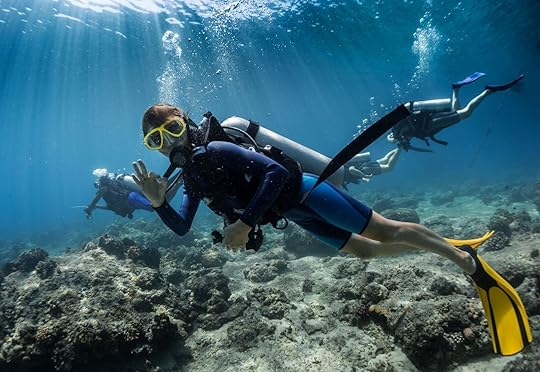
Photo: Dudarev Mikhail/Shutterstock
Finding a great drift diving location requires understanding a few key factors that create the right conditions. Strong ocean currents are essential for drift diving, so look for areas where large bodies of water funnel through narrow channels, between islands, or along steep underwater walls. Tides can also generate currents, so sites where oceans meet lagoons or smaller bodies of water are are ideal. Though they’re not on this list, you’ll find great drift diving at select sites near Madeira, Portugal; around Tubbataha Reef in the Philippines; and between Mauritius and Reunion in the Indian Ocean. If you’re keen on drift dives, ask your dive shop or dive resort if you can fit a drift dive into your schedule one day.

More like thisDiving50+ of the Best Places to Dive Around the World
The 5 Best Places in the World for Wreck Diving

See the full list of the world’s best places to dive
Wreck diving offers a unique blend of history, exploration, and technical skill, giving divers a chance to explore the past by swimming through sunken ships, airplanes, and more. Unlike reef diving, where coral and marine life are the primary focus, wreck diving is more about the structures themselves and navigating through windows, doors, and hallways of ships that are sometimes upside down or on their sides.
While many wrecks are accessible to recreational divers, actually going inside wrecks requires an advanced open water certification. You can also do additional training specifically for wrecks. You need to have excellent buoyancy control and be extremely aware of your feet, hands, and gear at all times, so you don’t stir up silt and dirt that can make visibility near zero. It’s also important not to touch wrecks as they’re extremely fragile, which means being able to move your body through tight, oddly shaped spaces without making contact with the ship. Navigation is key, and you need to be comfortable with dark, tight spaces and carry at least two lights on your body. The hazards of wreck diving aren’t always obvious — silt, limited access to the surface, and entanglement risks from fishing lines or exposed metal can pose serious dangers for untrained divers.
But for divers who do have those skills, going into wrecks can be one of the coolest, eeriest, and most unique ways to explore the past. Wreck diving also makes for pretty cool underwater photos, and is an excellent option for when visibility isn’t ideal for activities like reef diving. There’s also something just plain fascinating about swimming through an upside down ship from a century ago, wouldn’t you say?
We’ve recommended below some of the most popular and most convenient places to stay (mostly dive resorts) in each destination. Just so you know, Matador may collect a small commission from the links on this page if you decide to book a stay.
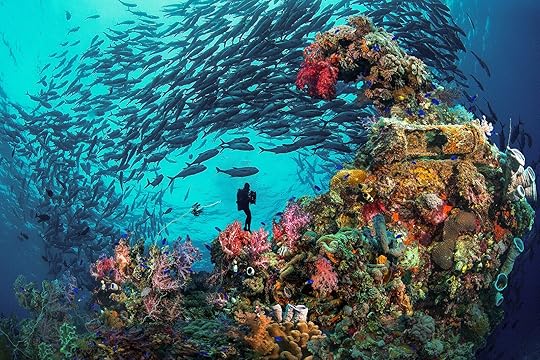
Photo: J.S. Lamy/Shutterstock
BermudaCan’t-miss sites: The Hermes Wreck, the Cristóbal Colón Wreck Where to stay: Grotto Bay Beach Resort has an on-site dive shop, daily boat dives, and the option to add an inclusive meal planRecommended operators: Dive Bermuda is the main go-to, with more than 30 years of experience in shipwreck divingBest season: Year-roundBermuda is home to more than 300 shipwrecks, earning its reputation as one of the world’s top wreck diving destinations. In fact, the famous “Bermuda Triangle” isn’t a supernatural force — it’s the geography. The island’s treacherous reefs, which rise suddenly from deep water, have claimed vessels from the 1600s to the 20th century, leaving behind well-preserved wrecks in shallow, clear waters. Many wrecks in Bermuda are at depths of less than 80 feet, accessible to most recreational divers.
Notable sites include the Cristóbal Colón, a massive Spanish liner that sank in 1936, and the Hermes, an intentionally sunk US Navy buoy tender resting upright at 80 feet. Bermuda’s warm Gulf Stream waters and lack of strong currents allow for extended bottom times and excellent visibility, often exceeding 100 feet. With a mix of wooden schooners, steamships, and wartime vessels, Bermuda offers some of the most visually stunning wreck dives in the Atlantic. Wreck diving is by far Bermuda’s bread and butter, so even if you don’t request to do a wreck dive, you almost certainly will.
Chuuk (or Truk) Lagoon, MicronesiaCan’t-miss sites: The San Francisco Maru/Million Dollar Wreck, the Fujikawa MaruWhere to stay: The Truk Blue Lagoon Resort isn’t fancy (nothing on Chuuk is), but it’s clean, comfortable, and caters to wreck diversRecommended operators: Chuuk Lagoon Dive CenterBest season: December to AprilChuuk Lagoon, formerly Truk Lagoon, is one of the world’s most significant wreck diving destinations, holding the remains of more than 60 Japanese warships, submarines, and aircraft from World War II. It was the site of Operation Hailstone, a 1944 US-led aerial attack that sank much of Japan’s Pacific fleet. That left behind a vast underwater battlefield, though it also means many of the wrecks are in deeper water (between 90 and 200 feet), making them only appropriate for advanced, mixed gas, and rebreather divers. Chuuk doesn’t have much in the way of luxury resorts, but the few accommodations it does have are very dive-focused.
What makes Chuuk’s wrecks especially fascinating is that they still hold what was onboard when the ships sank, including tanks, vehicles, mines, and artillery. Chuuk is a world-class destination for dedicated divers, but it’s hard to reach. You’ll have to take an island hopper flight from Guam, offered by United Airlines only. It’s often delayed, and will add a day or two to your travels so plan for trips of at least two weeks.
PalauCan’t-miss sites: The Iro Maru Wreck, Jake’s Seaplane, Chandelier CavesWhere to stay: Royal Resort Palau is luxurious but not wildly expensive, and within walking distance to the main dive shopsRecommended operators: Fish ‘n Fins or Sam’s Tours are the two biggies around KororBest season: November to AprilPalau is a remote paradise in the western Pacific, and like Chuuk, it’s renowned for its spectacular wreck diving. Unlike Chuuk, Palau offers more hotels and amenities on land, and many of its wrecks lie in shallower water, thanks to the lagoon surrounding the capital, Koror. The most famous wreck is probably Jake’s Seaplane, a propeller plane almost entirely intact in shallow water, making for ideal photography conditions. Other wrecks you can reach ion quick day trips include the Iro Maru — so large you’ll want to dive it more than once — and the Amatsu Maru, which is even larger than the Iro Maru.
Further out, you’ll find more unique diving opportunities, including the chance to dive in once-a-month deep-water snapper spawning and snorkel in Jellyfish Lake in Palau’s Rock Islands. It has hundreds of non-stinging jellyfish, making it perfect for a unique, safe swim among these fascinating creatures. (Note that Jellyfish Lake is ecologically sensitive and can periodically close — never try to visit when it’s off-limits.) When you do visit, follow all the rules about rinsing your snorkel gear, and wear a long-sleeve sun shirt instead of sunscreen to keep chemicals out of the lake.

Photos: lego 19861111/Shutterstock. DAAgius/Shutterstock, and Imagine Earth Photography/Shutterstock
MaltaCan’t-miss sites: The P31, The HMS MaoriWhere to stay: The Radisson Blu is a high-end hotel close to the water with dive packages offered through Starfish DivingRecommended operators: Paradise Diving offers wreck-specific dive trips, as well as hotel packages with the nearby Paradise Bay ResortBest season: Year-roundMalta is one of the top wreck diving destinations in the Mediterranean, with a high concentration of sunken ships, planes, and submarines scattered around its coastline. The island’s clear waters, easy shore access, and deep natural harbors have made it a strategic military location for centuries, leaving behind wrecks from World War II and the Cold War for divers, as well as more recent intentionally sunk ships to serve as artificial reefs. Many wrecks are between 30 to 130 feet deep.
Shore diving is particularly popular, with several wrecks accessible directly from the coastline, while deeper sites require boat access. Malta’s consistent diving conditions (allowing for 5mm wetsuits year round), warm summer waters, and strong diving infrastructure make it one of the most accessible (and impressive) wreck diving destinations in Europe.
North CarolinaCan’t-miss sites: The U-352, The Proteus WreckWhere to stay: The Bask Hotel in Morehead City is a modern, comfortable hotel close to all the top dive sitesRecommended operators: Olympus Dive Center has 50 years of experience exploring North Carolina’s underwater worldBest season: May to OctoberNorth Carolina, often called the “Graveyard of the Atlantic,” is one of the best wreck diving destinations in the US, with hundreds of sunken ships spanning centuries. Its wrecks include WWII U-boats, freighters, Civil War-era vessels, and even modern artificial reefs. Depths typically range from 60 to 130 feet, so while you can visit as a recreational diver, you’ll have many more wrecks available to you if you get your advanced certification, too. North Carolina wreck dives are particularly known for the local residents: sand tiger sharks are frequent visitors, offering the creepy-but-also-amazing chance to encounter sharks while exploring shipwrecks.
Most dive trips depart from Morehead City, Beaufort, or Wilmington, with operators running tours to wreck sites along the Outer Banks. The diving season runs from May to October, and you’ll need to decide what matters more: warmer water or better weather conditions. The waters are coldest early in the dive season, but the threat of hurricanes is less than it is in late summer and fall. Dive shops will reschedule or relocate dives if poor weather is expected, but it can still impact how many dive days you get during your trip. The water is generally cold at depth, so wear a 7mm wetsuit or rent a drysuit.
Where else can you dive for wrecks around the world?
A wreck in Sint Maarten, Dutch Caribbean. Photo: timsimages.uk/Shutterstock
Bad news for sailors is good news for divers: there are wrecks almost everywhere in the world. Most destinations will have at least one or two nearby wrecks accessible to divers, from the famous USS Kittiwake in Grand Cayman to the 400-foot-long WIT Shoal in St. Thomas and the SS Thistlegorm in the Red Sea. The locations above are known for their quantity of wrecks, making them good choices for divers keen to take a wreck-focused dive vacation. But if you’re hoping to see a wreck, just reach out to your dive shop in advance. It’s common for shops to change the daily dive sites based on guest preferences, so it never hurts to ask. Read more about a shipwreck turned into an underwater museum in Greece, seven shipwrecks on the West Coast you can see from land or sea, or how to go scuba diving on wrecks within Michigan’s Isle Royale National Park.
 More like thisDiving50+ of the Best Places to Dive Around the World
More like thisDiving50+ of the Best Places to Dive Around the World
The 5 Best Destinations in the World for Shore Diving
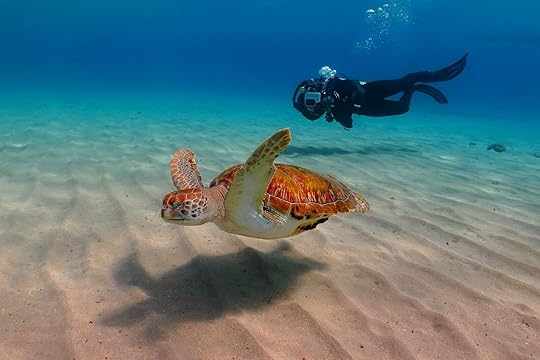
See the full list of the world’s best places to dive
Shore diving offers some of the most accessible and underrated dive experiences in the world. Unlike boat diving, which requires exact scheduling, sometimes lengthy boat rides, and often, a higher cost, shore diving allows divers to explore the underwater world on their own schedule and at their own pace. It can be guided or unguided; resorts that cater to the latter usually include unlimited tanks and car rentals, so you can truly choose your own adventure. Whether stepping into the water from a rocky coastline, wading through a sandy beach, or entering through a tidal lagoon, shore diving provides a relaxed to encounter marine life while staying close to land.
One of the biggest advantages of shore diving is flexibility. There’s no rush to fit into a boat’s departure schedule, no pressure to surface when other divers do, and no need for complex logistics. Divers can choose their depth, spend more time observing marine life, and return to shore whenever they want. For new divers, shore entries offer a more controlled environment, compared to back rolling off a boat.
However, shore diving comes with its own set of challenges. Entry and exit points can be tricky, especially in areas with surf, rocky terrain, or strong tidal changes. (You’ll probably want dive booties for walking across rocky beaches). Navigation requires a bit more planning, as there’s no dive guide pointing the way. And while shore dives tend to be shallower, tides and currents can still play a major role.
Despite these challenges, shore diving often provides incredible biodiversity in places where boats don’t typically visit. From seagrass beds teeming with macro life to dramatic drop-offs just beyond the shoreline, shore diving proves that you don’t need a boat to access world-class underwater experiences.
We’ve recommended below some of the most popular and most convenient places to stay (mostly dive resorts) in each destination. Just so you know, Matador may collect a small commission from the links on this page if you decide to book a stay.
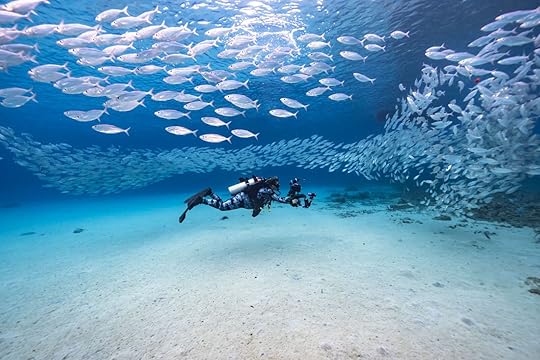
Photo: NaturePicsFilms/Shutterstock
BonaireCan’t-miss sites: Alice in Wonderland, the Hilma Hooker WreckWhere to stay: Buddy Dive, a purpose-built dive resort with its own house reefRecommended operators: Dive Friends Bonaire ensures dives are as fun and relaxing as the name would implyBest season: Year-roundBonaire is the perfect shore diving destination thanks to its calm, warm waters and lack of strong currents, making entries and exits easy for divers of all levels. Unlike many Caribbean islands, Bonaire is outside the hurricane belt, ensuring year-round diving with consistently great conditions. The island’s marine park is well-protected, and the reefs thrive with colorful fish, sea turtles, and coral formations — all just a short swim from shore. Shark encounters are extremely rare, allowing divers to explore the underwater world without concern. With more than 60 marked shore dive sites, Bonaire offers a stress-free diving experience. There’s a reason it’s known as the “Shore Diving Capital of the World.”
Kona, HawaiiCan’t-miss sites: ‘Alula Beach, Old AirportWhere to stay: Royal Kona Resort has a private beach and is within walking distance of popular shops like Jack’s Diving LockerRecommended operators: Jacks Diving Locker or Kona Shore Divers are each great picks Best season: Year-round, but summer offers the calmest conditions and best visibilityShore diving on Hawaii’s Big Island is among the best in the world, with easy access to lava tubes, coral reefs, and abundant marine life. The island’s calm, clear waters and minimal currents make it ideal for divers of all levels, while the volcanic coastline provides unique underwater formations like arches, caves, and swim-throughs. Two-Step (Honaunau Bay) is one of the most popular sites, known for above-average visibility, sea turtles, and abundant reef fish. Puako and Mile Marker 4 are both vibrant reefs with eels and occasional manta rays, while Old Kona Airport Beach is a great spot for macro photography and lava rock formations. With its lack of hurricanes, warm waters, and excellent visibility, the Big Island is a shore diver’s paradise year-round.
Amed, Bali, IndonesiaCan’t-miss sites: USAT Liberty Wreck, PyramidsWhere to stay: Puri Wirata Dive Resort and Spa has an infinity pool, beachfront access, reasonable prices, and an on-site dive shop (Bali Reef Divers)Recommended operators: Bali Reef Divers has multiple shops and a streamlined booking process Best season: Year-round, but summer offers the calmest conditions and best visibilityShore diving around Amed, Bali, offers easy access to coral reefs, black volcanic sand, and vibrant marine life, all set against the dramatic backdrop of Mount Agung. The Japanese Wreck is a highlight, sitting in shallow water just meters from the beach, covered in colorful corals and teeming with macro critters like pygmy seahorses and nudibranchs. Nearby, Jemeluk Bay has a healthy reef, artificial statues, and occasional reef sharks, making it a great spot for both beginners and experienced divers.
Amed’s calm waters and gentle currents provide ideal conditions for leisurely shore dives, with excellent visibility in the dry season. The town of Amed is far less crowded than other beach towns in Bali, with a laid-back atmosphere and more affordable hotels than better-known towns like Ubud. However, it’s easy to combine Amed with other dive locations in Bali, or even other islands like Nusa Lembongan (known for the chance to dive with mola mola, or giant sunfish).
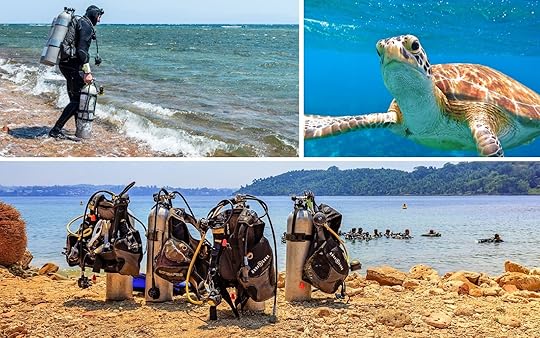
Photo: Arseniy Bobrov/Shutterstock. Roop_Dey/Shutterstock blue-sea.cz/Shutterstock
CuraçaoCan’t-miss sites: Playa Kalki, The Tugboat WreckWhere to stay: All West Apartments has fully equipped condos with private decks, direct beach access, and unlimited tanks left in the gear room each morningRecommended operators: Go West Diving or The Diving Bus have guided shore dives and gear rentalsBest season: Year-roundIt’s no surprise that Curaçao, located near Bonaire, also has fantastic shore diving. Curaçao offers easy beach access, calm waters, and some of the most vibrant coral reefs in the Caribbean. Like Bonaire, it’s outside of the hurricane belt, creating not just year-round diving opportunities, but a near-constant visibility of 75 feet or more. The reefs are healthy and free of wave and storm damage (though they do have plenty of lionfish), and the weather on your surface intervals is bound to be pretty darn nice, too.
Curaçao is a bit more developed than Bonaire, so it has a wider range of restaurants, hotels, and things to do for non-divers. Willemstad, the capital, is significantly larger than Kralendijk, the capital of Bonaire, so it’s a bit more of a tourist destination in its own right. That could make Curaçao a better place to dive for travelers who want access to some of the best shore diving in the world, but also want more in the way of nightlife, museums, shopping, and dining. But you won’t be sacrificing world-class diving, as the island has dozens of marked shore dives in addition to boat-accessed sites.
La Jolla, CaliforniaCan’t-miss sites: La Jolla Cove, Point Loma Kelp ForestWhere to stay: You can’t get much closer than the Grand Colonial La Jolla, where most of the rooms look out at La Jolla CoveRecommended operators: Marisa Dive Charters is female-owned and operates from a convenient location in Mission Bay, San DiegoBest season: AutumnShore diving in La Jolla is among the best in California, with close proximity to thriving kelp forests and diverse marine life. La Jolla Cove is famous for its towering kelp, bright orange garibaldi, and curious sea lions, making it a favorite for photographers and marine life enthusiasts. Just south, La Jolla Shores leads to the deep Submarine Canyon, where divers can spot stingrays, sevengill sharks, and seasonal squid runs. In late summer, hundreds of leopard sharks gather in the warm, shallow waters near the Shores (usually accessed from the beach directly in front of the Marine Room), creating a spectacular — yet harmless — encounter.
All of this makes La Jolla a great base for a vacation that includes some diving as well as time doing other activities — San Diego is absolutely packed with must-see sights. However, if you want to focus your trip primarily on diving, you could also make the quick drive north of La Jolla to add a two-night trip to Catalina Island (boats often leave from south of Los Angeles) or dive at Shaw’s Beach, about an hour north of La Jolla. You can also dive some excellent wrecks from San Diego itself. Conditions around San Diego are often excellent in summer and fall, with calmer waters and good visibility inside the kelp forests.
Where else to go shore diving around the world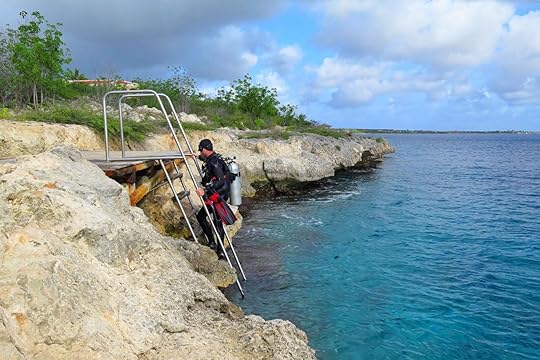
Photo: blue-sea.cz/Shutterstock
Though the five destinations above are well-known for their shore diving, they’re far from the only options. In fact, most dive destinations around the world have at least one or two shore dives — whether you’re on the tiny Puerto Rican island of Vieques or at a luxury resort on the Red Sea. Check out more of our favorite shore dive spots, explore the best lake diving locations in the US, or start daydreaming about one of these 40 gorgeous Airbnbs scattered across the Caribbean.
 More like thisDiving50+ of the Best Places to Dive Around the World
More like thisDiving50+ of the Best Places to Dive Around the World
5 Places to Go for the Best Muck Diving in the World

See the full list of the world’s best places to dive
Muck diving might sound unappealing, but it has become a popular type of diving among underwater photographers and those eager to encounter rare marine life. It’s a specialized form of scuba diving where you explore areas with sediment-rich, often murky bottoms, where some of the rarest and most peculiar creatures in the oceans make their homes. The dive sites may appear barren and lifeless, but if you know what you’re looking for, they can be an underwater treasure hunt.
Muck diving is often found in volcanic regions or near river mouths, and it takes a keen eye to find some species. Patient divers may be rewarded with sightings of otherworldly creatures, such as the elusive mimic octopus, psychedelic frogfish, and the enigmatic flamboyant cuttlefish (yes, that’s really what it’s called). Muck diving hotspots are scattered across the globe, with particular concentrations in the Indo-Pacific region, where biodiversity reaches its zenith.
Much of the appeal of muck diving lies in the thrill of discovery, kind of like going on safari. It attracts photographers who appreciate the challenge of spotting and shooting images of some of the ocean’s most bizarre and beautiful inhabitants. Unlike traditional reef diving, muck dives often involve slow, methodical exploration of small areas, with divers hovering just above the bottom, their eyes scanning for the slightest movement or hint of camouflage. Good buoyancy is key so as to not stir up silty bottoms.
We’ve recommended below some of the most popular and most convenient places to stay (mostly dive resorts) in each destination. Just so you know, Matador may collect a small commission from the links on this page if you decide to book a stay.

Photo: Fiona Ayerst/Shutterstock
Anilao, PhilippinesCan’t-miss sites: Sombrero Island, Secret Bay Where to stay: Solitude Acacia Resort caters to muck divers and has an on-site shopRecommended operators: Bauan Divers Sanctuary Best season: November to MayAnilao has earned a reputation as one of the world’s premier muck diving destinations. This coastal region just a few hours from Manila has an incredible diversity of cryptic species that thrive in its sediment-rich waters. Lucky divers may be able to spot elusive mimic octopuses or vibrantly colored nudibranchs. The area is particularly renowned for its nudibranch populations (it’s known as the “nudibranch capital of the world”), with hundreds of species documented during annual surveys. Any dive resort is bound to be packed with photographers looking for colorful creatures like the Ceratosoma alleni or Batangas sea slug.
Dive sites range from shallow, silty bays to deeper, rubble-strewn slopes, each offering unique encounters with rare and unusual marine life. Night dives are especially rewarding, as many creatures emerge under the cover of darkness. You can even dive through underwater steam vents, swimming through bathtub-warm bubbles rising from thermal vents beneath the seabed.
Ambon Bay, IndonesiaCan’t-miss sites: Anywhere on Laha ReefWhere to stay: Ambon Dive Resort is always packed with frogfish enthusiastsRecommended operators: Laha Dive PackerBest season: October to MayAmbon Bay is one of the most unique diving environments in the world, and has long drawn muck diving enthusiasts with its extraordinary marine life. It’s 14-mile-long, five-mile-wide bay with a sandy, silty bottom that’s home to an array of unusual species. The bay’s claim to fame is the elusive psychedelic frogfish (Histiophryne psychedelica), discovered there in 2008 and now considered the holy grail of underwater macro photography. It’s exceedingly rare and spotted typically only once or twice a year in the area, making sightings a coveted experience (and talking point) for divers.
Beyond the psychedelic frogfish, Ambon Bay has an impressive diversity of other frogfish species, as well as ghost pipefish, rhinopias, and the newly discovered Bryozoan goby. The bay’s unique ecosystem, as well as sunken natural debris and dead coral, is a haven for these bizarre and beautiful creatures, cementing Ambon’s status as a world-class muck diving destination. Many dive operators and shops in the area rent underwater camera gear, like GoPros with housings.
Lembeh Strait, IndonesiaCan’t-miss sites: Critter Hunt, Teluk Kembahu Where to stay: Thalassa Dive Resort Lembeh is a mid-priced boutique hotel with an on-site dive shopRecommended operators: Two Fish DiversBest season: Year-roundMuck diving in Lembeh Strait is a chance to dive with bizarre and elusive marine creatures, set against a backdrop of black volcanic sand slopes and nutrient-rich waters. If Anilao is the nudibranch capital of the world, Lembeh is the critter capital of the world, where patient explorers are rewarded with sightings of otherworldly species. It’s in Lembeh that the mimic octopus was discovered, known for its ability to impersonate other marine species as a defense mechanism.
The strait’s warm waters typically range from about 79 to 84 degrees Fahrenheit, and depths as shallow at 15 feet make many sites suitable for beginner divers.
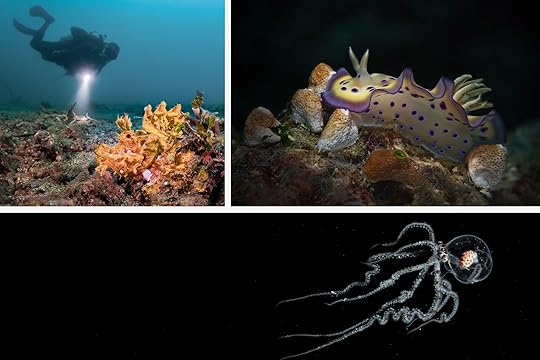
Photos: Sascha Janson/Shutterstock, Oksana Maksymova/Shutterstock, and Paul Tuazon/Shutterstock
St. Vincent, SVGCan’t-miss sites: Layou Wall, The Bat Cave (advanced) Where to stay: Petit St. Vincent is a luxe resort with an on-site dive shopRecommended operators: Serenity Dive offers guided dives and dive packages in partnership with boutique hotelsBest season: December to AprilUnlike the bright coral reefs typically associated with the region, St. Vincent’s underwater terrain is a mix of soft sediment, scattered rubble, and seagrass beds — perfect conditions for elusive critters. Because it’s a volcanic island, it has black sand above and below the water, making for stunning backdrops on macro photos. There’s also not as much tourism on St. Vincent as there is on nearby islands, which helps marine creatures thrive with less human disturbance.
Divers with keen eyes may encounter frogfish in an array of colors, cryptic pipefish, flamboyant nudibranchs, and even the rare donkey dung sea cucumber (yep, that’s the real name for that one, too). Juvenile scorpionfish and flying gurnards may be hiding in the sand, while octopuses and decorator crabs may be just below you, blending seamlessly into the debris. St. Vincent’s muck sites may not have as much name recognition as other destinations, but for macro lovers, they offer some of the richest biodiversity in the Caribbean.
Vancouver Island, CanadaCan’t-miss sites: Argonaut Wharf, or around Nanoose BayWhere to stay: Coast Bastion Hotel in Nanaimo is next to the lively Harbourfront Walkway Recommended operators: OceanFix near Campbell River, Nanaimo Dive Outfitters around NanaimoBest season: November to FebruaryVancouver Island is renowned for its rugged coastline, temperate rainforests, and excellent tidepooling — which explains why the large island’s muck diving is so good, too. Some of the most sought-after species include the Pacific spiny lumpsucker and the grunt sculpin, a small, camouflaged fish that resembles a walking pinecone. There are also all kinds of nudibranch (including the intricate and colorful decorated warbonnet), plus seahorse-like pipefish and, of course, the giant Pacific octopus.
Water temperatures around Vancouver Island remain relatively cold throughout the year, usually between 40 to 55 degrees Fahrenheit. Dry suits are all but mandatory. Peak visibility is in the winter, from October to February. It usually drops in late February through mid-March, when the annual herring spawn significantly reduces visibility for about three weeks. However, since you don’t need exceptional visibility for muck diving, there’s no reason not to give it a try if you’re an enthusiastic diver, no matter what time of year you’re on the island.
Other well-known muck diving sites around the world
Photo: Bass Supakit/Shutterstock
Most parts of the world will have some level of muck, so to speak, or at least an area with a silty bottom known for critters. Aside from the muck diving destinations above, you’ll also find muck diving around the world at specific sites well-known for the type of ocean critters that live in mucky environments. That includes Dauin in the Philippines, with volcanic black sand and abundant macro life like blue-ringed octopuses, and Alor (near Komodo), with rare species like the rhinopias scorpionfish, Coleman shrimp, and zebra crabs. Mabul Island in Malaysia, Maumere Bay in Indonesia, and Dumaguete in the Philippines — the list goes on. Talk to your dive shop before your trip if you’re interested in a detail-oriented muck dive, and they may know the perfect spot to take you.
Read more about the best little-known dive sites in Southeast Asia, or where to find pygmy seahorses and blue-ringed octopuses, and remind your non-certified friends that they can come on trips, too, since lots of muck diving sites are also near excellent snorkeling sites. 
Matador Network's Blog
- Matador Network's profile
- 6 followers



